医学专业英语词根
- 格式:doc
- 大小:185.00 KB
- 文档页数:15
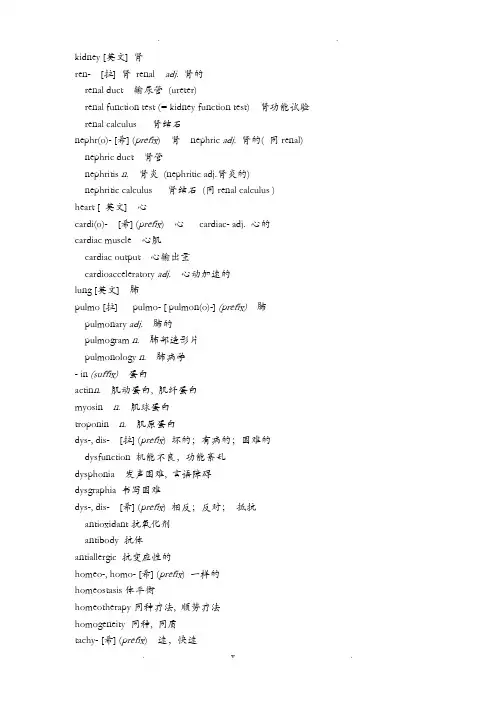
kidney [英文] 肾ren- [拉] 肾renal adj.肾的renal duct 输尿管(ureter)renal function test (= kidney function test) 肾功能试验renal calculus 肾结石nephr(o)- [希] (prefix) 肾nephric adj.肾的( 同renal) nephric duct 肾管nephritis n. 肾炎(nephritic adj.肾炎的)nephritic calculus 肾结石(同renal calculus )heart [ 英文] 心cardi(o)- [希] (prefix) 心cardiac- adj. 心的cardiac muscle 心肌cardiac output 心输出量cardioacceleratory adj.心动加速的lung [英文] 肺pulmo [拉] pulmo- [ pulmon(o)-] (prefix)肺pulmonary adj. 肺的pulmogram n. 肺部造影片pulmonology n.肺病学- in (suffix)蛋白actin n. 肌动蛋白, 肌纤蛋白myosin n. 肌球蛋白troponin n. 肌原蛋白dys-, dis- [拉] (prefix) 坏的;有病的;困难的dysfunction 机能不良,功能紊乱dysphonia 发声困难, 言语障碍dysgraphia 书写困难dys-, dis- [希] (prefix) 相反;反对;抵抗antioxidant抗氧化剂antibody 抗体antiallergic 抗变应性的homeo-, homo- [希] (prefix) 一样的homeostasis体平衡homeotherapy同种疗法, 顺势疗法homogeneity 同种, 同质tachy- [希] (prefix) 速,快速tachycardia n.心悸, 心动过速tachyphylaxis n.快速免疫;快速脱敏;快速耐受tachypnea n.呼吸急促-osis [希] (suffix) 异常或病理情况sclerosis 硬化atherosclerosis动脉粥样硬化症arteriosclerosis动脉硬化geno- [希]〔prefix〕基因genohormone 基因激素genome . 基因组genospecies 基因型群fibr- [拉]〔prefix〕纤维fibrescope . 纤维窥镜fibrillation n.纤维性颤抖fibrinolysis n.纤维蛋白溶解myc(o)- [希]〔prefix〕真菌mycetology n.真菌学mycoplasma n. 支原体,支原菌mycotoxicology n.真菌毒理学myo- [希]〔prefix〕肌肉myoalbumin 肌清蛋白, 肌白蛋白myoatrophy .肌萎缩myocardial n.心肌的-algia [希] (suffix) 痛neuralgia .神经痛odontalgia .牙痛rectalgia 直肠痛path(o)- [希] (prefix) 病理,疾病pathography 病情记录pathogenesis 发病机制pathomorphism 病理形态学chrom(o)- [希] (prefix) 色chromoblast 成色细胞chromosomal mutation 染色体突变chromophototherapy 色光疗法neur(o) - [希] 神经neurobiology神经生物学neurocirculatory [解]神经(与)循环系统的neurodermatitis [医]神经性皮肤炎tox(o)- [希] 毒, 毒素toxoid 类毒素toxinemia . 毒血症toxuria 尿毒症-asis [希] (suffix) 状态,情况〔病的〕cholelithiasis 胆石病nephrolithiasis 肾石病schistosomiasis .血吸虫病enter- [希] (prefix) 肠enteralgia 肠痛enteritis 肠炎enterectomy 肠切除术ep /i- [希] (prefix) 上eparterial 动脉上的[ep /i 上+ arterial 动脉的] epithelial[生]上皮的, [植]皮膜的epidermitis 表皮炎gastro- gastr-[希] (prefix)胃gastritis 胃炎gastrin 胃泌激素的gastrorrhea 胃液分泌过多gastrolith胃石immuni-, immun (o)- [希] (prefix) 免疫immunopetence 免疫活性immunocyte 免疫细胞immunodeficiency 免疫缺损-ectomy [希] (suffix) 切除术adenectomy 腺切除术ovariectomy 卵巢切除术splenectomy 脾切除术intra- [拉] (prefix) ,在….之intra-appendicular 阑尾的intra-arterial 动脉的intra-cerebral 小脑的pneum(o)- [希] (prefix) 呼吸,肺,气,肺炎pneumocardial 肺心的pneumocephalus 颅腔积气pneumococcosis . 肺炎球菌-coccus, [拉] 球菌-cocci (suffix)〔pl.〕球菌staphylococcus .葡萄球菌streptococci 链球菌-gen [希] (suffix) 原antigen 抗原glycogen .肝糖,动物淀粉pathogen .病原体-gram [希] (suffix) 图,像;书写,记载electrocardiogram .心电图odontogram 牙面描记图, 齿纹tomogram .断层照片hyper- [希](prefix)过多,过度,超过hyperadrenia .肾上腺功能亢进hyperglycemia 高血糖,血糖过多hyperlipidemia 高脂血症,血脂过多-cyte [希](suffix)细胞acanthocyte 棘红细胞leucocyte 白细胞lymphocyte 淋巴细胞poly- [希](prefix) 多,多数polyclonal 多细胞的polyase 多糖酶,聚合酶polycythemia 红细胞增多症erythr(o)- [希](suffix) 红erythroblast .成红细胞erythromycin 红霉素erythropenia .红细胞减少-lith [希] (suffix) 石,结石broncholith.支气管石cholelith .胆石urolith 尿(结)石brady- [希] (prefix) 缓,慢,迟钝bradyarrhythmia 听觉迟钝bradyarthria 言语过缓bradycardia 心动过缓lev(o)- [拉] (prefix) 左,向左,左旋levocardia 左位心levodopa 左旋多巴levoduction 左旋眼pro- [拉,希] (prefix) 前,以前;前体(酶或激素的) proaccelerin.前加速素,前加速因子proactivator 前激活剂,激活剂原proal adj. 向前运动的kine- [希] (prefix) 运动kinematics.运动学;动力学kineplastics运动成形切断术kinesalgia 肌动痛,运动痛-oma [希] (suffix) 瘤cerebroma .脑瘤epithelioma 上皮瘤, 上皮癌hemangioma n. [医]血管瘤psych- [希] (prefix) 灵魂,精神,心智,呼吸psychedelic 产生幻觉的psychiatry 精神病学psychopath 精神变态者psychotherapy 心理疗法xantho- [希] (prefix) 黄色的xanthoma 黄色瘤xanthopathia黄肤症xanthoprotein黄色蛋白xanthopsy黄视症-ostomy [希] (suffix) 造口术,造瘘术,吻合术cholecystoduodenostomy.胆囊十二指肠吻合术gastrostomy 胃造口术neocystostomy .膀胱再造口术-otomy [希] (suffix) 切开术oophorotomy .卵巢切开术,卵巢切除术ototomy 耳切开术urethrotomy .尿道切开术-penia [希] (suffix) 减少,缺乏erythropenia 红细胞减少glycopenia 低血糖, 血糖过少leukopenia 白细胞减少hemat(o)-,hemo- [希] (prefix) 血hematology 血液学hematocyte 血细胞hemotoxic 血中毒的leuk(o)- [希] (prefix) 白, 白细胞leukemia 白血病leukoderma 白斑病leukoencephalitis 白质脑炎myel(o)- [希] (prefix) 骨髓, 脊髓myeloid cell 骨髓细胞【同marrow cell】myelogenous.骨髓形成的myelitis 脊髓炎cyt(o)- [希] (prefix) 细胞cytodifferentiation 细胞分化cytopenia血细胞减少cytomorphosis 细胞变形peri- [希] (prefix) 周, 周围peripheral 外周的periarthritis of shoulder肩周炎pericardial effusion心包积液duoden(o)- [拉] (prefix) 十二duodenoscope 十二指肠镜duodenum 十二指肠duodenectomy 十二指肠切除术cancri-, cancr(o)- [拉] carcin(o)- [希] (prefix) 癌carcinogen n. 致癌剂,致癌原carcinogenesis 致癌作用carcinophobia 癌病恐惧secret- [希] (prefix) 分泌secretin 分泌素secretion 分泌物secretomotor 促进分泌的-scope,-scopy [希] (suffix) 镜;镜检endoscopy 镜检查术hysteroscope 宫腔镜l aparoscopy腹腔镜检查-itis [希] (suffix) 炎症appendicitis 阑尾炎,盲肠炎hepatitis 肝炎peritonitis腹膜炎。
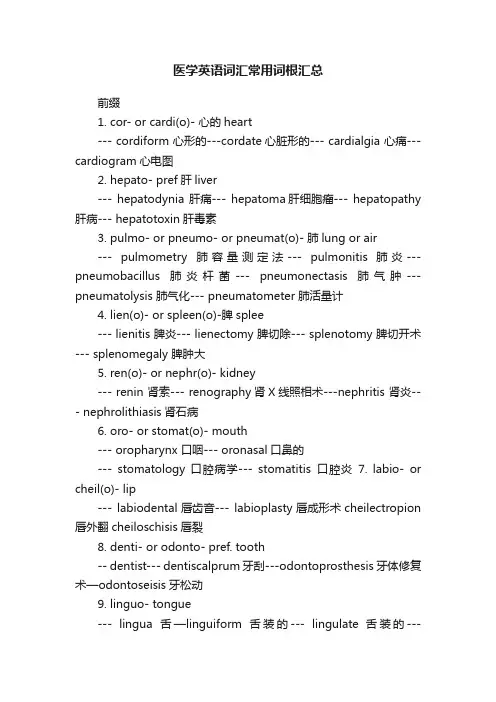
医学英语词汇常用词根汇总前缀1. cor- or cardi(o)- 心的heart--- cordiform 心形的---cordate心脏形的--- cardialgia 心痛--- cardiogram心电图2. hepato- pref肝liver--- hepatodynia 肝痛--- hepatoma肝细胞瘤--- hepatopathy 肝病--- hepatotoxin肝毒素3. pulmo- or pneumo- or pneumat(o)- 肺lung or air--- pulmometry肺容量测定法--- pulmonitis 肺炎--- pneumobacillus 肺炎杆菌--- pneumonectasis 肺气肿--- pneumatolysis 肺气化--- pneumatometer 肺活量计4. lien(o)- or spleen(o)-脾splee--- lienitis 脾炎--- lienectomy 脾切除--- splenotomy 脾切开术--- splenomegaly 脾肿大5. ren(o)- or nephr(o)- kidney--- renin 肾索--- renography肾X线照相术---nephritis 肾炎--- nephrolithiasis肾石病6. oro- or stomat(o)- mouth--- oropharynx 口咽--- oronasal口鼻的--- stomatology 口腔病学--- stomatitis口腔炎7. labio- or cheil(o)- lip--- labiodental唇齿音--- labioplasty唇成形术cheilectropion 唇外翻cheiloschisis唇裂8. denti- or odonto- pref. tooth-- dentist--- dentiscalprum牙刮---odontoprosthesis 牙体修复术—odontoseisis牙松动9. linguo- tongue--- lingua舌—linguiform舌装的--- lingulate 舌装的---linguodental舌齿音10. gingiv- or ulo- 牙龈gum---gingivectomy龈切除术—gingivitis齿龈炎---ulorrhagia龈出血---ulorrhoea 龈糁血11. palato- or urano- 腭palatine---palatitis腭炎---palatogram口盖图---palatograph腭动扫描器palatography腭位图的制作12. pharyngo- 咽pharynxpharyngalgia咽痛pharyngocele咽囊肿pharyngoplasty咽成形术pharyngoplegia咽肌麻痹13. laryngo- 喉larynx,throatLaryngalgia喉痛laryngemphraxis喉阻塞laryngostenosis 喉狭窄laryngoxerosis喉干燥14. esophag(o)- 食管esophagusEsophagectasis食管扩张esophagectopy食管异位esophagocele食管突出esophagotomy食管切开术15. gastr(o)- stomachgastrin 胃泌激素gastrectasia胃胀gastroanastomosis 胃吻合术gastroptosis胃下垂16. enter(o)-肠intestineenterelcosis 肠溃疡enteremphraxis肠阻塞enterorrhagia 肠出血enterocolostomy 小肠结肠吻合术17. colo- or coli- or col- pref结肠. colon colicodynia 结肠痛colimycin结肠霉素coloclysis结肠灌洗colonorrhea粘液性结肠炎18.proct(o)- or archo-直肠rectumProctectomy直肠切除术proctitis 直肠炎proctoscope 直肠镜- proctoscopy直肠镜观察术19.ano-肛门anusAnogenital肛门与生殖器的anorectal肛门直肠的anorectum肛门直肠部anoscope肛门镜20. vesico- or cysti- or cysto- 膀胱bladder Vesicotomy膀胱切开术cystirrhagia膀胱出血cystocele 膀胱彭出cystourethritis膀胱尿道炎21. thoraco- chest or 胸thoraxThoracocyllosis胸畸形thoracicolumbar 胸腰的thoracoschisis 胸裂thoracoplasty胸廓成形术22. ventro- or coeli(o)- or laparo- 腹部belly、abdomenVentrotomy剖腹术coelialgia腹痛Coeliorrhaphy腹腔缝术laparotome剖腹术23. bili- or chole-胆bilebilichol 胆汁醇- biligenic生胆汁的cholecyst胆囊cholelithiasis 胆石病24. oculo- or ophthalmo- eyeoculist 眼科医生oculomotor 眼球运动的ophthalmoplegia眼肌麻痹ophthalmoscope检眼镜25. lacrimo- or dacryo-眼泪tearlacrimator 催泪物质-lacrimal 泪腺的lacrimatory agent 催泪剂lacrimation 泪26. palpebro- or blepharo-眼睑eyelidpalpebra 眼睑palpebral 眼睑的blepharochalasis 眼睑皮肤松弛症blepharospasm眼睑痉挛27. kerato-角角质horn or comeakeratectasia 角膜膨胀keratinase 角蛋白酶keratoplasty 角膜成形术keratosis角化症28.auri- or oto- earauriphone 助听器auristilla滴耳剂otorrhea耳液溢,耳漏otosclerosis 耳硬化症29.naso- or rhino- noseNasitis鼻炎nasopharynx 鼻咽rhinocleisis鼻腔闭塞rhinocnesmus 鼻痒30.broncho- or bronch- 支气管pref. bronchus; bronchialBronchiectasis支气管扩张bronchiolitis细支气管炎bronchorrhagia支气管出血bronchospasm支气管痉挛31. gonado- 生殖腺seedGonadectomy性腺切除术gonadotrophin 促性腺激素gonadotrope 生殖腺32. andro- 男的雄性的maleandrocentrism大男子主义androgen 雄激素andrology 男科学androsterone 雄淄酮33. gyne- or gyneco- femaleGynecic女性的gynecium 雌蕊雌蕊群gynecologist 妇科医生gynecopathy 妇科病34. vagino- or colpo- 阴道vaginaVaginectomy阴道切除术vaginotomy阴道切开术colpoptosis 阴道下垂colporrhaphy阴道缝合术35. oophor- 卵巢ovaryOophorectomy卵巢切除术oophorectomize切除。
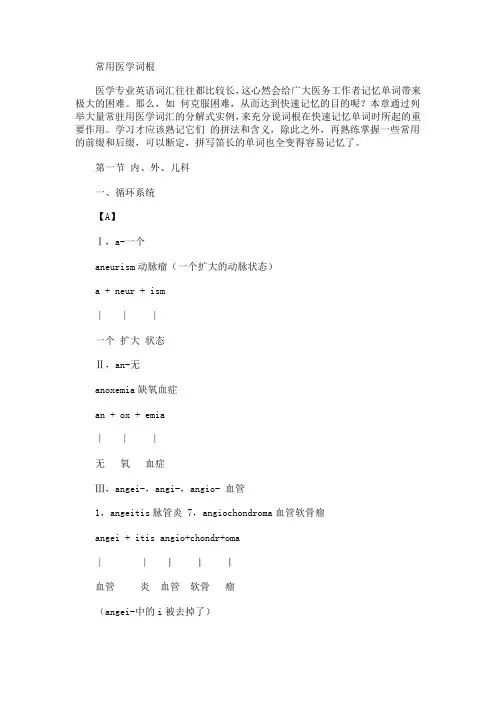
常用医学词根医学专业英语词汇往往都比较长,这心然会给广大医务工作者记忆单词带来极大的困难。
那么,如何克服困难,从而达到快速记忆的目的呢?本章通过列举大量常驻用医学词汇的分解式实例,来充分说词根在快速记忆单词时所起的重要作用。
学习才应该熟记它们的拼法和含义,除此之外,再熟练掌握一些常用的前缀和后缀,可以断定,拼写笛长的单词也全变得容易记忆了。
第一节内、外、儿科一、循环系统【A】Ⅰ,a-一个aneurism动脉瘤(一个扩大的动脉状态)a + neur + ism∣ ∣∣一个扩大状态Ⅱ,an-无anoxemia缺氧血症an + ox + emia∣ ∣∣无氧血症Ⅲ,angei-,angi-,angio- 血管1,angeitis脉管炎 7,angiochondroma血管软骨瘤angei + itis angio+chondr+oma∣ ∣︱︱︱血管炎血管软骨瘤(angei-中的i被去掉了)2,angiectasis血管扩张 8,angiodermatitis皮血管炎angi + ectasis angio+dermat+itis∣ ∣︱︱︱血管扩张血管皮炎3,angitis脉管炎 9,angiolipoma血管脂肪瘤ang + itis angio+lip+oma∣ ∣ ︱︱︱脉管炎血管脂肪瘤(angi-不的I被去掉了)4,angioblast成血管细胞 10,angioneuromyoma血管神经肌瘤angio + blast angio+neuro+my+oma∣ ∣︱︱︱︱血管成…细胞血管神经肌瘤5,angiocardiography心血管造影术 11,angioparalysis血管麻痹病angi + cardio + graphy angio+paraly+sis∣ ∣ ∣ ︱︱︱血管心脏照相术血管麻痹病6,angiocardiopathy心血管病angio+cardio+pathy︱︱︱血管心病Ⅳ,arter-,arteri-,arteria-,arterio-动脉1,artery动脉arte + ry︱︱动脉 n.suf(名词后缀)(arter-中的r被去掉了)2,arterial动脉的arteri + al︱︱动脉 a.suf(…的)(形容词后缀)3,arteriarctia 动脉缩窄arteri + arct + ia︱︱︱动脉缩窄病4,arteriectasia 动脉扩张arteri + ectas + ia︱︱︱动脉扩张病5,arteriectomy 动脉切除术arteri + ectomy︱︱动脉切除术7,angiochondroma血管软骨瘤angio+chondr+oma︱︱︱血管软骨瘤(angei-中的i被去掉了)8,angiodermatitis皮血管炎angio+dermat+itis︱︱︱血管皮炎9,angiolipoma血管脂肪瘤angio+lip+oma︱︱︱血管脂肪瘤(angi-不的I被去掉了)10,angioneuromyoma血管神经肌瘤angio+neuro+my+oma︱︱︱︱血管神经肌瘤11,angioparalysis血管麻痹病angio+paraly+sis︱︱︱血管麻痹病Ⅴ,asthma-气喘1,asthma气喘2,asthmatic气喘的asthmat+ic︱︱气喘 a.suf(…的)Ⅵ,ather-athero-粥样的1,atheroma 粥样(粉)瘤ather + oma︱︱粥样(粉)瘤2,atherogenesis 粥样硬化形成athero + gene + sis︱︱︱粥样产生病(指硬化)3,atherogenic 致粥样硬化的athero + gen + ic︱︱︱粥样致 a.suf(…的)4,atheromatosis 粥样硬化病athero+matosis︱︱粥样病5,atheronecrosis 粥样坏死athero+necro+sis︱︱︱粥样坏死病6,atherosclerosis 动脉粥样硬化athero + sclero + sis︱︱︱粥样硬化病7,atherosis 粥样硬化athero + sis︱︱粥样病Ⅶ,atri- atrio- 心房1,atrial 心房的 5,atriotome 心房切开刀atri + al atrio + tome︱︱︱︱心房 a.suf 心房(切开)刀2,atrium 心房 6,atriotomy 心房切开术atri + um atri + otomy︱︱︱︱心房 n.suf 心房切开术3,atriocarotid (心)房颈动脉的 7,atrioventricular 房室的atrio + carotid atrio + ventricul + ar︱︱︱︱︱心房颈动脉的心房室 a.suf(与…有关的)4,atrioseptopecy 房间隔修补术atrio + septo + pexy︱︱︱心房间隔修补术【B】Ⅰ,bi-1,bicuspid 二尖瓣,二尖瓣的 2,bigemina 二联脉bi+cuspid bi + gemin + a︱︱︱︱︱二尖(瓣)二成对 n.sufⅡ,brady- 徐缓、迟缓1,bradycardia 心动过缓 3,bradydiastole 心舒张期延长brady + cardia brady+diastole︱︱︱︱过缓心(动)延长舒张期2,bradycrotic 脉搏徐缓的brady+crotic︱︱徐缓脉搏的【C】Ⅰ,capil-, capillar-, capillar-, capillari-, capillaro- 毛细(血管)1,capillary 毛细血管的 5,capillariomotor 毛细血管运动capill + ary capillario+motor︱︱︱︱毛细血管 a.suf(与…有关的)毛细血管运动2,capillarectasis 毛细血管扩张 6,capillarioscopy 毛细显微镜检capillar + ectasis capillario+scopy︱︱︱︱毛细血管扩张毛细镜检查3,capillaritis 毛细管炎 7,capillaropathy 毛细管病capillar+itis capillaro+pathy︱︱︱︱毛细炎毛细管病4,capillarity 毛细现象或作用capillari + ty︱︱毛细 n.suf(表特性)Ⅱ,cardia-, cardio- 心1,cardiac 心的 7,cardiant 心兴奋剂cardi + ac cardi + ant︱︱︱︱心 a.suf( …的) 心药剂(医学上)(cardia-中的a被省略)2,cardialgia 心痛,胃灼痛 8,cardiasthma 心性喘息cardi + algia cardi + asthma︱︱︱︱心,胃痛心喘息3,cardiamorphia 心畸形 9,cardiovascular 心血管的cardia + morphia cardio + vascul + ar︱︱︱︱︱心形态病心血管 a.suf4,carditis 心炎 10,cardiophonography 心音图card + it is cardio+phono+graphy︱︱︱︱︱心炎心血管 a.suf5,cardiogenic 心原性的 11,cardiopulmonary 心肺的cardio + gen + ic cardio+pulmon+ary︱︱︱︱︱︱心原 a.suf心肺 a.suf6,cardiomegaly 心肥大cardio+megaly︱︱心肥大关于医学的英文方面可以参考医学英语:/english/index.html上有关文章。
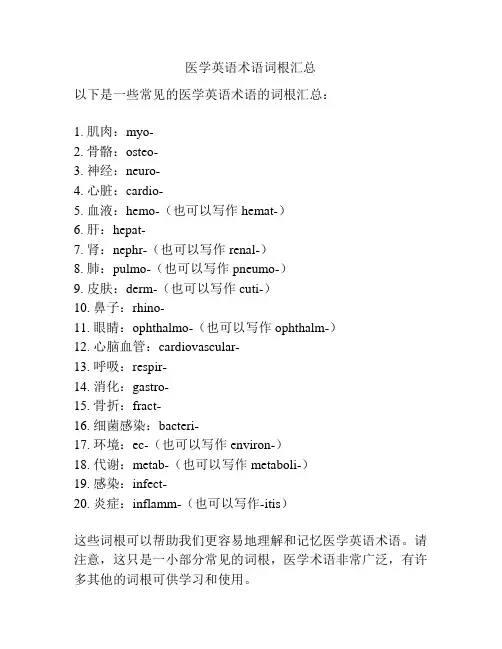
医学英语术语词根汇总
以下是一些常见的医学英语术语的词根汇总:
1. 肌肉:myo-
2. 骨骼:osteo-
3. 神经:neuro-
4. 心脏:cardio-
5. 血液:hemo-(也可以写作hemat-)
6. 肝:hepat-
7. 肾:nephr-(也可以写作renal-)
8. 肺:pulmo-(也可以写作pneumo-)
9. 皮肤:derm-(也可以写作cuti-)
10. 鼻子:rhino-
11. 眼睛:ophthalmo-(也可以写作ophthalm-)
12. 心脑血管:cardiovascular-
13. 呼吸:respir-
14. 消化:gastro-
15. 骨折:fract-
16. 细菌感染:bacteri-
17. 环境:ec-(也可以写作environ-)
18. 代谢:metab-(也可以写作metaboli-)
19. 感染:infect-
20. 炎症:inflamm-(也可以写作-itis)
这些词根可以帮助我们更容易地理解和记忆医学英语术语。
请注意,这只是一小部分常见的词根,医学术语非常广泛,有许多其他的词根可供学习和使用。
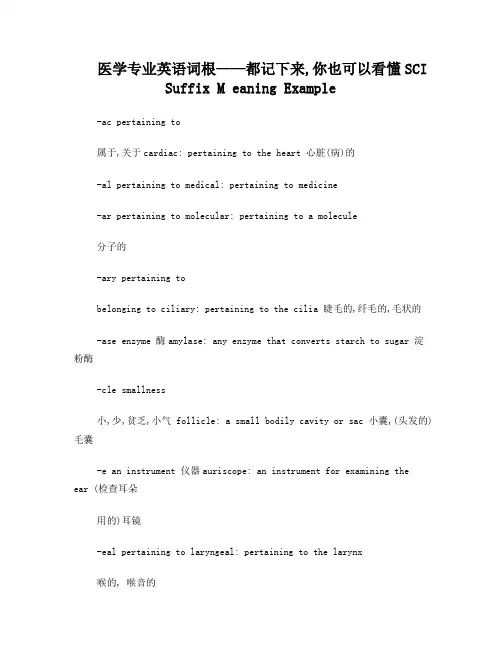
医学专业英语词根——都记下来,你也可以看懂SCISuffix M eaning Example-ac pertaining to属于,关于cardiac: pertaining to the heart 心脏(病)的-al pertaining to medical: pertaining to medicine-ar pertaining to molecular: pertaining to a molecule分子的-ary pertaining tobelonging to ciliary: pertaining to the cilia 睫毛的,纤毛的,毛状的-ase enzyme 酶amylase: any enzyme that converts starch to sugar 淀粉酶-cle smallness小,少,贫乏,小气follicle: a small bodily cavity or sac 小囊,(头发的)毛囊-e an instrument 仪器auriscope: an instrument for examining theear (检查耳朵用的)耳镜-eal pertaining to laryngeal: pertaining to the larynx喉的, 喉音的-ia condition; quality phobia: abnormal fear 恐惧,害怕-ic pertaining to toxic: pertaining to toxin有毒的;因中毒引起的-ics study of; name of a science paediatrics: study of children, their development and diseases 儿科学-ine/i n substance 物质insulin:substance (hormone) produced by the islets of Langerhans inthe pancreas胰岛素-ism process or condition alcoholism: excessive drinking of alcohol which becomes addictive 酒精中毒-ist one who specializes in 精通于……的人pharmacologist: a doctor who specializes in the study of dru gs 药理专家-itis inflammation refers to a part in……部位的炎症rhinitis: inflammation of the nasal passages 鼻炎,鼻粘膜炎-(i)um relation to a whole; related to与……相关endometrium: inner lining of the uter子宫内膜-ive characterizes by antitussive: a drug that suppresses coughing止咳药-let tiny; small droplet: a tiny drop 小滴-ment the result or product of an ac tion development: thing which develops or is being developed; ac tion of becoming mature-oid resembling; like mucoid: resembling mucus像粘液样的 -ole little; small centriole: the small dense structure in the middle of the centrosome细胞中心粒;中心体-oma tumor; swelling refers to a do er dermatofibroma: fibrous tumor of the skin皮肤纤维瘤-or/-e r either a person or thingreceptor: a sensory nerve ending that responds to various sti muli 感受器,受体-ory characterized by; pertaining t o suspensory: which is hanging down悬吊式,悬带-ose sugarfructose: fruits sugar found in honey and some fruit 果糖 -osis abnormal conditiononychocryptosis: abnormal condition of a hidden nail 嵌甲 -ous pertaining topoisonous: pertaining to poison; also containing poison 有毒的,分泌毒素的 -some sbodiesribosome: the body of nucleic acid 核糖体 -um structure; thing; substance结构,物质magnesium: a white metallic chemical substance 镁(金属元素) -y condition; act; process dystrophy: disorder caused by defective nutrition or metabolism 营养不良The following is a list of the most commonly used compound suffixes Suffix Meaning Example-algia pain; painful; condition arthralgia: pain in a joint 关节痛--ase enzymeprotease: digestive enzyme 蛋白酶 -blast embryo 胚,胚胎,人类胚胎hemocytoblast: blast cell 血胚细胞,原始血细胞-carcin oma malignant tumor developing from connective tissue 相关组织的恶性肿瘤adenocarcinoma: malignant tumor developing from glandula r tissue 腺癌-cele protrusion; distention 突出;膨胀,延伸 esophagocele: abnormal distention of the esophagus 食管突出-cente sis surgical puncture 手术穿孔 p aracentesis: surgical puncture of a cavity for the aspiration of fluid 穿刺术-capni acarbon dioxide 二氧化碳 acapnia: absence of carbon dioxide 血液二氧化碳缺乏 -cide killgermicide: (substance) which can kill germs 杀菌剂 -clast cellphagocyte:cell, especially a white blood cell, which can surro und and destroy other cells 噬菌细胞 -dynia pain glossodynia: pain in the tongue 舌痛-ectasi a/ expansion; dilation(膨胀,扩张) atelectasis: incomplete expansion of the lungs at birth 肺不张-ectasi s-ectom y surgical excision or removalofgastrectomy: surgical removal of the stomach胃切除术-edem a excessive accumulation of serous fluid 水肿myxoedema: condition caused when the thyroid gland doesnot produce enough thyroid hormone 粘液腺瘤病,粘液水肿-emia blood condition leukemia: any of several malignant diseases where an abnormal number of leucocytes form in the blood 白血病-emesisvomiting 呕吐hematemesis: the vomiting of blood 咯血;吐血-gen something that produced or prouduces pathogen: a microorganism or agent capable of producing di sease 病菌,病原体-genes is production 生产spermatogenesis: formation and development of spermatozoa in the testes精子发生-globin protein蛋白质hemoglobin: an iron-containing protein produced by erythrocytes 血红素-gnosis knowledge diagnosis: the process of identifying the nature or presenceof a disease through knowledge and examination-gram image; picture electrocardiogram: a graphic record of the electrical activityof heart muscle or heartbeat used in the diagnosis of heart disease.Abbr. ECG and EKG. Syn. cardiogram心电图-graph (y) process of recording记录过程electocardiography: the process of making or recording electrocardiograms. Syn. cardiography 心电图记录-iasis condition; state情况,状况cholelithiasis: the formation of gallstones 胆石症-iatry/ -iatrics healing, frequently refers toa branch of medicine 康复,常指医学的一个分支podiatry: treatment of foot disorders足部医疗-lith stone cholelith: a gallstone; a stone formed in the gallbladder 胆结石-logy the study of cytology: the science study of cells 细胞学-logist one who studies and treats urologist: a physician who specializes in the practice of urology 泌尿科医生-lysis breakdown, destruction hemolysis: the destruction or breakdown of red blood cellswith release of hemoglobin溶血-malaciasoftening osteomalacia: softening of bone 骨软化-mania extreme compulsion or preo ccupation强迫症kleptomania: a morbid, uncontrollable compulsion to steal 盗窃癖-megal y giant acromegaly: a condition in which there is an enlargement ofthe facial bones as well as those of the lungs 肢端肥大症-metry /-meter measurement spirometry: measurement of the volume of air inhaled and exhaled or the air capacity of the lungs肺(活)量测定(法),呼吸量测定(法)-odyniapain cardiodynia: pain in the heart region 心痛,胸痛-one hormone荷尔蒙,激素parathormone: which regulates calcium balance among theblood, bones, and teeth甲状旁腺激素-opia a defect in the eye眼睛的毛病myopia: being short-sighted 近视-opsy to view biopsy: excision of live tissue for microscopic diagnosis活检-osis morbid condition病态的sclerosis: abnormal hardening 硬化症-osmia smell anosmia: loss of the sense of smell嗅觉丧失-ostom y process of making an opening into or a connection between造瘘gastrostomy: surgical construction of an opening from the surface of the abdomen into the stomach胃造口术-oxia level of oxygen氧水平hypoxia: a low oxygen level or a lackof oxygen in body tissues组织缺氧-pathy disease; diseased condition ophthalmopathy: any eye disease眼病-penia deficiency leukopenia: deficiency of leukocytes in the blood. Syn. leukocytopenia白细胞减少症-pepsiadigestion eupepsia: good digestion 消化良好--pexy a fixing or setting firmly in place by suturing 缝合固定hepatopexy: surgical fixation of a displace liver肝固定术-phagia/phagyeating; swallowing 吃,吞咽dysphagia: difficulty in swallowing吞咽困难-phil attraction吸引,具有吸引力的事物basophil: type of leucocyte or white blood cell which contain s granules嗜碱性粒细胞-phobi a fear xenophobia: irrational fear of strangers对外国人的恐惧,憎恶-plasia formation; development hyperplasia: overdevelopment or enlargement of an organ or tissue增生,数量型肥大-phoniavoice dysphonia: difficulty in speaking发声困难-plasm formation; growth or substance of formationcytoplasm: jelly substance in the cell细胞浆-plasty surgical repair osteoplasty: surgical repair of the bone骨整形术,骨成形术--plegi stroke; paralysis 中风thermoplegia: heat or sunsrtoke热射病a-pnea breathing eupnea: normal breathing呼吸正常,平静呼吸--ptosi s a falling, the dropping or sagging of an organ器官下移hepatoptosis: abnormally low position of the liver肝下垂-ptysis spitting分散melanoptysis: spitting of the spleen黑色痰液;咳黑痰-poiesisproduction hemopoiesis: production of blood cells 造血作用,生血作用-rrhag e/-rrhagi a bursting forth of blood 出血menorrhagia: very heavy bleeding during menstruation 月经过多-rrhaphysurgical sewing or suturing splenorrhaphy: suture of the spleen脾修补术-rrhea overflow hydrorrhea: watery discharge液溢-(o)rrh exis splitting or rupture 撕裂,破裂,疝气amniorrhexis: rupture of the amniotic ac羊膜破裂-sarco ma malignant tumor developingfrom connective tissueliposarcoma: malignant tumor containing fat脂肪肉瘤-schesi s a holding back; suppressionof discharge阻碍;抑制排放uroschesis: suppression of urine闭尿,尿潴留-sclerosisa hardening dermatosclerosis: hardening of the skin硬皮病-scope instrument for viewing stethoscope: an instrument for performing medicate ausculation听诊器-scopy process of examining visuallyhepatoscopy: examination of the liver 肝检查-spas m involuntary contraction angiospasm: sudden contraction of the muscles in a blood vessel血管痉挛-stasis suppression; stoppage; cont rol; arrest抑制,中止hemostasis: the arrest of bleeding 止血,止血法-steno sis abnormal narrowing of a duct or canal管、道德异常狭窄laryngostenosis: abnormal narrowing of the larynx 喉狭窄-stomy surgical opening to the outsi de of the body造口colostomy: surgical operation to make an opening from the c olon结肠造口术-tentionpressure hypertention: high blood pressure 高血压-thera py treatment physiotherapy: treatment of disease by physical means物理疗法--tion process hospitalization: the process of being hosipitalized 住院-tocia labor; birth 生产embryotocia: abortion 流产-tome tool for incision arthrotome: instrument for cutting a joint 关节刀-tomy process of cutting into gastrotomy: incision of the stomach 胃切开术-tropia turning 转弯,变向esotropia: turning inward of the eye内斜视-troph y nourishment or development of an organ器官的营养、发育dystrophy: disorder caused by defective nutrition or metabolism营养不良-uria a condition of the urine(小便)dysuria: difficultly in passing urine 排尿困难-versionturning eversion: a turning outward外翻,翻转Here is a table of the most commonly used prefixesPrefix Meaning Examplea-/an- without; not aphasia: the inability to understand written or spoken wordsor to speak meaningfully失语症ab- away from abortion: expulsion from the uterus流产ad- to; toward; near adnasal: near the nose 近鼻的acro- a point or tip acronyx: growing into the flesh嵌甲alb- white albino: a person lacking normal pigmentation白发病者amb-/ ambi- both ambisexual、bisexual: (person) who is sexually attracted to both males and famales 双性恋amphi-/ ampho - both; both sides amphicentric: beginning and ending in the same vessel起止同源的血管ana- up; back again anabolism: process of building up complex chemical substances on the basis of simpler ones 合成代谢Angio- a blood vessel angioma: benign tumor formed of blood vessel 血管瘤ante- before antenatal: during the period between conception and childbirth 出生前的,怀孕期的anti- against antidepressant: (drug) used to treat depression抗抑郁剂audi- hearing; sound audiometry: science of testing hearing听力测定auto- self autoantibody: antib ody formed to attack the body’s own cells自身抗体bi- two; twice bicellular: two cells两室的bio- living organisms生命体biochemistry: chemistry living tissues 生物化学brady- slow bradycardia: slow rate of heart contraction, shown by a slowpulse rate心动过缓carcin- carcinoma or cancer癌;瘤carcinogen: a cancer-causing substance致癌物cata- downwards; under; against;along with cataract: condition where the lens of the eye gradually beco mes hard and opaque白内障centi- one hundredth百分之一centimeter: unit of measurement of length(=one hundredthof a meter)厘米co(n)- with or together consanguineous: blood relationship血亲的,血缘的,密切的contra - against contraception: prevention of pregnancy by using devices or drugs 避孕法,节育法de- removal or loss decaffeinated: (coffee) with the caffeine removed 脱去咖啡因的deca- ten decagram: ten grams 十克deci- tenth deciliter: unit of measurement of liquid(=one tenth of a little)1/10公升di- two diglossia: a double tongue使用两种语言dia- through; between; apart; ac ross diathermy: process of (treating) through heat 透热疗法dis- reversal or separate disintegrate: to come to pieces分解,破裂dys- bad; difficult; disordered dysarthrosis: deformity or malformation of a joint关节变形echo- sound echocardiography: ultrasonography of the heart心回波描记,超声心动描记术ect-/ ecto- outside or outer ecchondroma: benign tumor on the surface of cartilage or bone外生软骨瘤en- in; within enostosis: benign growth inside a bone内生骨疣endo- inside endocardium: membrane which lines the heart心内膜epi- on; over epidermis: outer layer of skin表皮ery- red erythrocyte: mature non-nucleated red blood cell红细胞eso- inward; within(向内) esotropia: turning inward of the eye内斜视eu- good eugenics: study of how to improve the human race by genetic selection优生学ex-/ exo-out of exhale: to breath out 呼出extra- outside extracapsular: outside a capsule囊外的hemi- half hemiplegia: severe paralysis affecting one side of the body偏瘫,半身麻痹,半身不遂hydro- water hydrocele: collection of watery liquid found in a cavity such as the scrotum阴囊积水hyper- higher or too much hyperglycaemia: excess of glucose in the blood高血糖症hypo- less or too little hypokalaemia: deficiency of potassium in the blood 低血钾in- in or into inbreeding: breeding between a closely related male and female 近亲交配in- not incoherent: not able to speak in a way which makes sense语无伦次infra- below or beneath infrapatellar: below or beneath the patella 髌inter- between interlobular: between lobules小叶间的intra- inside intramedullary: inside the bone marrow or spinal cord 髓内itro- into introvert: person who thinks only about himself and his ownmental state性格内向的人mal- bad or abnormal malfunction: abnormal working of an argan机器等运转失常;失灵;出现故障meta- changes metaplasia: change of one tissue to another化生,转化,组织变形micro- very small microcyte: abnormally small red blood cell小红细胞mid- middle midcarpal: between the two rows of carpal bones腕骨间的milli- one thousandth milligram: unit of measurement of weight 毫克mis- error or wrong miscarriage: spontaneous abortion流产multi- many multigravida: a woman who is pregnant and has been pregnant at least twice before 经产孕妇noct- at night nocturia: passing abnormally large quantity of urine when asleep in bed at night夜尿症nona- nine or the nineth nonagon: flat shape which has nine sides 九边形octa- eight octan: every eight days八日热;每隔八日发一次的odont- teeth odontology: study of teeth and associated structures, and their disordersonco- tumours oncology: scientific study of new gowths肿瘤学oro- mouth orolingual: pertaining to the mouth and tongue口与舌的pachy- thickening pachysomia: condition where soft tissues of the body become abnormally thick躯体肥厚pali-/ palin- against; pathologic repetition病态的重复palindromic: (disease) which recurs复发的,再发的pan-/p ant-/ panto- all pancytopenia: abnormal depression of all the cellular elements of the blodd全血细胞减少症para- similar to or near; changed or beyond paralyse or paralyze: to weaken (muscles) so that they canno t function使麻痹,使瘫痪pen-/ penta- five pentosuria: excretion of pentoses in the urine戊糖尿per- through percutaneous: done or administered through the skin经皮的,由皮的peri- around pericystitis: inflammation of tissue around the bladder膀胱周炎pero- deformed or defective畸形有缺陷的peromelia: congenital deformity of the limbs 四肢不全pharm aco- drugs pharmacology: study of drugs or medicines, and their action,properties and characteristics药理学,药物学pleo-/ pleio- too many pleokaryocyte: condition where a greater than normal number of cells in cerebrospinal fluid多核细胞pluri- more pluriglandular: pertaining to or affecting several glands多线性的pneum -/ pneun mo- air or the lungs; breathing pneumonia: inflammation of a lung肺炎poly- touching many organs polyphagia: condition where a patient eats too much; morbid desire for every king of food 多食症,杂食症post- after or later postprandial: after a meal 餐后的pre- before of in front of premature: early or before the normal time 过早的,早产presby-old age presbyopia: an old person’s sight fails g radually老花眼pro-/ supin-/ pron- before or in front oflying on the backbend forwardprognosis: prediction of the outcome of a disease预测;预后quadri -/ quint- fourfive/fifthquadruplet or quad: one of four babies born to a mother at the same time四胞胎radio- ray or radiation radiotherapy: treating a disease by exposing the affected part to radioactive 放射疗法semi- half semiptosis: the downward sagging of half or part of an organ轻度睑下垂sub- under submucous: under the mucous membrane粘膜下层的;粘膜下的super- above; extremely superalbuminosis: abnormal increase of albumin白蛋白过多syn- with; joint syndesmosis: joint where the ones are tightly linked by ligaments 韧带联合supra- above; over suprarenal: (situated) above a kidney 肾上腺tachy- fast tachycardia: rapid beating of the heart 心动过速tetra- four tetracycline: antibiotic used to treat a wide range of bacterialdiseases 四环素trans- across; through; beyond transmission: the transfer, as of a disease, from one person to another 传染tri- three tricephalus: a fetus with three heads 三头畸胎ultra- beyond; excess ultrasonics: the science dealing with ultrasonic sound waves超声波学uni- one uniglandular: affecting only one gland 单腺的xen(o)- strange; foreign xenograft: a graft of tissue transplant between animals of different species 异种移植物。
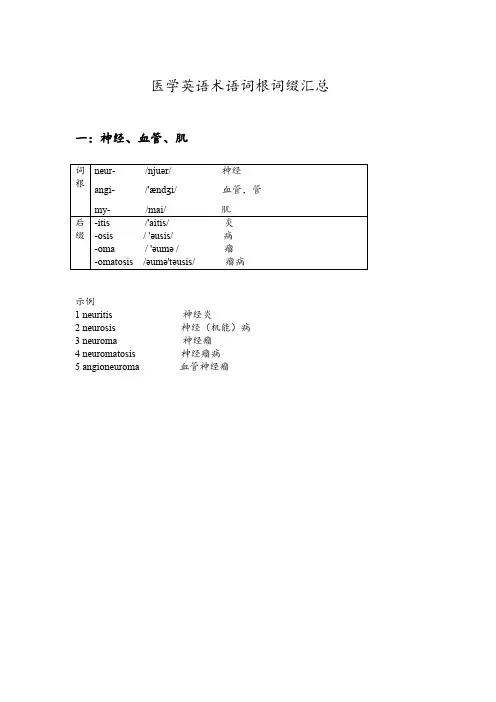
医学英语术语词根词缀汇总一:神经、血管、肌词根neur-/njuər/神经angi-/'ændʒi/血管,管my-/mai/肌后缀-itis/'aitis/炎-osis/'əusis/病-oma/'əumə/瘤-omatosis/əumə'təusis/瘤病示例1neuritis神经炎2neurosis神经(机能)病3neuroma神经瘤4neuromatosis神经瘤病5angioneuroma血管神经瘤二:胃、肠、肝、胆词根gastr-/gæstr/胃enter-/'entər/肠,小肠hepat-/'hepət/肝chol-/kəul/胆chole-/'kəuli/cholangi-/kəu’lændʒi/胆管后缀-ia/iə/(表示疾病状态)-algia/'ældʒiə/痛alg-/ælg/(仍可用作词根)-dynia/'diniə/痛-rrhagia/'reidʒiə/出血-ptosis/'ptəusis/下垂以ia为结尾的词,其重音在倒数第三个音节上。
英语的重读元音的长短与音节的开闭有关。
在开音节读长音,如:-rrhagia。
在闭音节一般读短音,如:-algia。
如重读元音是y或i,不论音节开闭,一般读短音。
如-dynia。
示例1gastralgia胃痛2gastrodynia胃痛3gastrorrhagia胃出血4gastroptosis胃下垂三:气管、支气管、肺词根trache-/'treiki/气管bronch-/brɔŋk/支气管pneum-/nju:m/肺,呼吸,空气pneumat-/'nju:mət/肺,呼吸,空气pneumon-/nju:’məun/肺后缀-pathy/('ɔ)pəθi/病path/pæθ/(仍可作词根)-logy/('ɔ)lədʒi/学说-list/ist/者,人员-logist/('ɔ)lədʒist/学者,学家-scopy/('ɔ)skəpi/镜检法,检查法-graphy/('ɔ)grəfi/X线照相术,描记法,造影术当倒数第二个音节的元音是短音,重音就落在倒数第三个音节上。
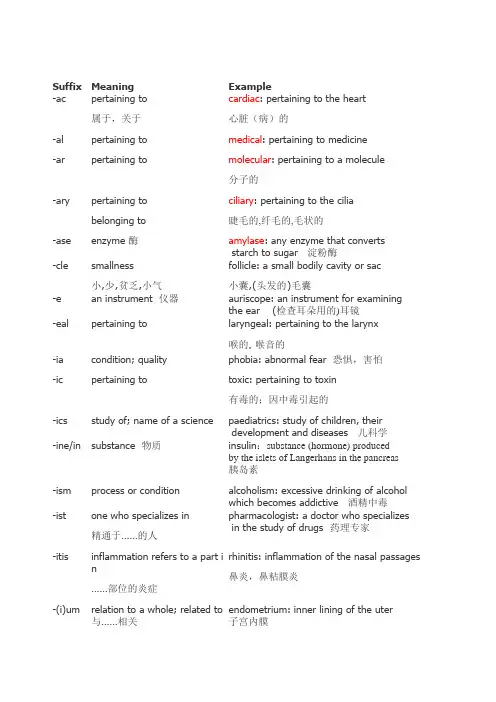
Suffix Meaning Example -ac pertaining to属于,关于cardiac : pertaining to the heart 心脏(病)的 -alpertaining to medical : pertaining to medicine -ar pertaining to molecular : pertaining to a molecule分子的-ary pertaining tobelonging tociliary : pertaining to the cilia 睫毛的,纤毛的,毛状的 -aseenzyme 酶 amylase : any enzyme that converts starch to sugar 淀粉酶 -clesmallness 小,少,贫乏,小气 follicle: a small bodily cavity or sac 小囊,(头发的)毛囊 -ean instrument 仪器 auriscope: an instrument for examining the ear (检查耳朵用的)耳镜 -ealpertaining to laryngeal: pertaining to the larynx 喉的, 喉音的 -iacondition; quality phobia: abnormal fear 恐惧,害怕 -ic pertaining to toxic: pertaining to toxin有毒的;因中毒引起的-ics study of; name of a science paediatrics: study of children, theirdevelopment and diseases 儿科学-ine/in substance 物质 insulin :substance (hormone) producedby the islets of Langerhans in the pancreas胰岛素-ism process or condition alcoholism: excessive drinking of alcoholwhich becomes addictive 酒精中毒-ist one who specializes in 精通于……的人pharmacologist: a doctor who specializesin the study of drugs 药理专家 -itis inflammation refers to a part i n ……部位的炎症rhinitis: inflammation of the nasal passages鼻炎,鼻粘膜炎-(i)um relation to a whole; related to 与……相关 endometrium: inner lining of the uter子宫内膜-ive characterizes by antitussive: a drug that suppressescoughing止咳药-let tiny; small droplet: a tiny drop 小滴-ment the result or product of an acti on development: thing which develops or is being developed;action of becoming mature-oid resembling; like像mucoid: resembling mucus 粘液样的-ole little; small centriole: the small dense structure in themiddle of the centrosome细胞中心粒;中心体-oma tumor; swelling refers to a doe r dermatofibroma: fibrous tumor of the skin 皮肤纤维瘤-or/-er either a person or thing receptor: a sensory nerve ending thatresponds to various stimuli感受器,受体-ory characterized by; pertaining to suspensory: which is hanging down悬吊式,悬带-ose sugar fructose: fruits sugar found in honeyand some fruit 果糖-osis abnormal condition onychocryptosis: abnormal condition ofa hidden nail 嵌甲-ous pertaining to poisonous: pertaining to poison; alsocontaining poison 有毒的,分泌毒素的-somes bodies ribosome: the body of nucleic acid核糖体-um structure; thing; substance 结构,物质magnesium: a white metallic chemical substance 镁(金属元素)-y condition; act; process dystrophy: disorder caused by defectivenutrition or metabolism 营养不良The following is a list of the most commonly used compound suffixesSuffix Meaning Example-algia pain; painful; condition arthralgia: pain in a joint 关节痛--ase enzyme protease: digestive enzyme 蛋白酶-blast embryo胚,胚胎,人类胚胎hemocytoblast: blast cell 血胚细胞,原始血细胞-malignant tumor developingfrom connective tissue 相关组adenocarcinoma: malignant tumor developing from glandular tissue 腺癌carcinoma 织的恶性肿瘤-cele protrusion; distention突出;膨胀,延伸esophagocele: abnormal distention of the esophagus 食管突出-centesis surgical puncture 手术穿孔paracentesis: surgical puncture of a cavityfor the aspiration of fluid 穿刺术-capnia carbon dioxide 二氧化碳acapnia: absence of carbon dioxide血液二氧化碳缺乏-cide kill germicide: (substance) which can killgerms杀菌剂-clast cell phagocyte:cell, especially a white bloodcell, which can surround and destroy othercells 噬菌细胞-dynia pain glossodynia: pain in the tongue 舌痛-ectasia/ -ectasis expansion; dilation(膨胀,扩张)a telectasis: incomplete expansion of thelungs at birth 肺不张-ectomy surgical excision or removal of gastrectomy: surgical removal of thestomach胃切除术-edema excessive accumulation ofserous fluid 水肿myxoedema: condition caused when the thyroid gland does not produce enough thyroid hormone 粘液腺瘤病,粘液水肿-emia blood condition leukemia: any of several malignant diseaseswhere an abnormal number of leucocytesform in the blood 白血病-emesis vomiting 呕吐hematemesis: the vomiting of blood 咯血;吐血-gen something that produced orprouduces pathogen: a microorganism or agent capable of producing disease 病菌,病原体-genesis production 生产spermatogenesis: formation and developmentof spermatozoa in the testes精子发生-globin protein蛋白质hemoglobin: an iron-containing proteinproduced by erythrocytes 血红素-gnosis knowledge diagnosis: the process of identifying thenature or presence of a disease throughknowledge and examination-gram image; picture electrocardiogram: a graphic record ofthe electrical activity of heart muscle orheartbeat used in the diagnosis of heartdisease.Abbr. ECG and EKG. Syn. cardiogram 心电图-graph(y) process of recording记录过程electocardiography: the process of making or recording electrocardiograms. Syn. cardiography 心电图记录-iasis condition; state情况,状况cholelithiasis: the formation of gallstones 胆石症-iatry/ -iatrics healing, frequently refers to abranch of medicine 康复,常指医学的一个分支podiatry: treatment of foot disorders足部医疗-lith stone cholelith: a gallstone; a stone formed inthe gallbladder 胆结石-logy the study of cytology: the science study of cells 细胞学-logist one who studies and treats urologist: a physician who specializesin the practice of urology 泌尿科医生-lysis breakdown, destruction hemolysis: the destruction or breakdown ofred blood cells with release of hemoglobin溶血-malacia softening osteomalacia: softening of bone 骨软化-mania extreme compulsion orpreoccupation强迫症kleptomania: a morbid, uncontrollable compulsion to steal 盗窃癖-megaly giant acromegaly: a condition in which there isan enlargement of the facial bones as wellas those of the lungs 肢端肥大症-metry/ -meter measurement spirometry: measurement of the volumeof air inhaled and exhaled or the air capacityof the lungs肺(活)量测定(法),呼吸量测定(法)-odynia pain cardiodynia: pain in the heart region 心痛,胸痛-one hormone荷尔蒙,激素parathormone: which regulates calciumbalance among the blood, bones, andteeth甲状旁腺激素-opia a defect in the eye眼睛的毛病myopia: being short-sighted 近视-opsy to view biopsy: excision of live tissue for microscopicdiagnosis活检-osis morbid condition病态的sclerosis: abnormal hardening 硬化症-osmia smell anosmia: loss of the sense of smell嗅觉丧失-ostomy process of making an opening into or a connection between gastrostomy: surgical construction of an opening from the surface of the abdomen into the stomach胃造口术造瘘-oxialevel of oxygen 氧水平 hypoxia : a low oxygen level or a lack of oxygen in body tissues 组织缺氧 -pathydisease; diseased condition ophthalmopathy : any eye disease 眼病 -penia deficiency leukopenia : deficiency of leukocytes inthe blood. Syn. leukocytopenia 白细胞减少症-pepsia digestioneupepsia : good digestion 消化良好 --pexya fixing or setting firmly in place by suturing 缝合固定 hepatopexy: surgical fixation of a displace liver 肝固定术 -phagia/phagyeating; swallowing 吃,吞咽 dysphagia: difficulty in swallowing 吞咽困难 -phil attraction 吸引,具有吸引力的事物basophil: type of leucocyte or white bloodcell which contains granules 嗜碱性粒细胞 -phobia fear xenophobia: irrational fear of strangers对外国人的恐惧,憎恶-plasia formation; development hyperplasia: overdevelopment or enlargementof an organ or tissue 增生,数量型肥大-phonia voice dysphonia: difficulty in speaking 发声困难 -plasmformation; growth or substance of formation cytoplasm: jelly substance in the cell 细胞浆 -plasty surgical repair osteoplasty : surgical repair of the bone骨整形术,骨成形术--plegia stroke; paralysis 中风 thermoplegia: heat or sunsrtoke 热射病-pnea breathingeupnea : normal breathing 呼吸正常,平静呼吸 --ptosis a falling, the dropping or sagging of an organ 器官下移 hepatoptosis : abnormally low position ofthe liver 肝下垂-ptysis spitting 分散 melanoptysis : spitting of the spleen黑色痰液;咳黑痰-poiesis production hemopoiesis: production of blood cells造血作用,生血作用-rrhage/ -rrhagiabursting forth of blood 出血 menorrhagia: very heavy bleeding duringmenstruation 月经过多 -rrhaphy surgical sewing or suturingsplenorrhaphy : suture of the spleen 脾修补术-rrhea overflow hydrorrhea: watery discharge 液溢-(o)rrhexis splitting or rupture 撕裂,破裂,疝气amniorrhexis: rupture of the amniotic ac羊膜破裂-sarcoma malignant tumor developing fro m connective tissue liposarcoma: malignant tumor containing fat 脂肪肉瘤-schesis a holding back; suppression ofdischarge阻碍;抑制排放uroschesis: suppression of urine闭尿,尿潴留-sclerosis a hardening dermatosclerosis: hardening of the skin硬皮病-scope instrument for viewing stethoscope: an instrument for performingmedicate ausculation听诊器-scopy process of examining visually hepatoscopy: examination of the liver 肝检查-spasm involuntary contraction angiospasm: sudden contraction of themuscles in a blood vessel血管痉挛-stasis suppression; stoppage; control;arrest抑制,中止hemostasis: the arrest of bleeding 止血,止血法-stenosis abnormal narrowing of a duct o r canal管、道德异常狭窄laryngostenosis: abnormal narrowing of the larynx 喉狭窄-stomy surgical opening to the outside of the body造口colostomy: surgical operation to make an opening from the colon结肠造口术-tention pressure hypertention: high blood pressure 高血压-therapy treatment physiotherapy: treatment of diseaseby physical means物理疗法--tion process hospitalization: the process of beinghosipitalized住院-tocia labor; birth 生产embryotocia: abortion 流产-tome tool for incision arthrotome: instrument for cutting a joint关节刀-tomy process of cutting into gastrotomy: incision of the stomach 胃切开术-tropia turning 转弯,变向esotropia: turning inward of the eye内斜视-trophy nourishment or development of an organ器官的营养、发育dystrophy: disorder caused by defective nutrition or metabolism营养不良-uria a condition of the urine(小便)dysuria: difficultly in passing urine 排尿困难-version turning eversion: a turning outward外翻,翻转Here is a table of the most commonly used prefixesPrefix Meaning Examplea-/an- without; not aphasia: the inability to understand writtenor spoken words or to speak meaningfully失语症ab- away from abortion: expulsion from the uterus流产ad- to; toward; near adnasal: near the nose 近鼻的acro- a point or tip acronyx: growing into the flesh嵌甲alb- white albino: a person lacking normalpigmentation白发病者amb-/ ambi- both ambisexual、bisexual: (person) who is sexuallyattracted to both males and famales 双性恋amphi-/ ampho- both; both sides amphicentric: beginning and ending inthe same vessel起止同源的血管ana- up; back again anabolism: process of building up complexchemical substances on the basis of simplerones 合成代谢Angio- a blood vessel angioma: benign tumor formed of bloodvessel血管瘤ante- before antenatal: during the period betweenconception and childbirth 出生前的,怀孕期的anti- against antidepressant: (drug) used to treatdepression抗抑郁剂audi- hearing; sound audiometry: science of testing hearing听力测定auto- self autoantibody: antibody formed to attack thebody’s own cells自身抗体bi- two; twice bicellular: two cells两室的bio- living organisms生命体biochemistry: chemistry living tissues生物化学brady- slow bradycardia: slow rate of heart contraction,shown by a slow pulse rate心动过缓carcin- carcinoma or cancer癌;瘤 carcinogen: a cancer-causing substance致癌物cata- downwards; under; against;along with cataract: condition where the lens of theeye gradually becomes hard and opaque白内障centi- one hundredth百分之一centimeter: unit of measurement of length(=one hundredth of a meter)厘米co(n)- with or together consanguineous: blood relationship血亲的,血缘的,密切的contra- against contraception: prevention of pregnancyby using devices or drugs 避孕法,节育法de- removal or loss decaffeinated: (coffee) with the caffeineremoved 脱去咖啡因的deca- ten decagram: ten grams 十克deci- tenth deciliter: unit of measurement of liquid(=one tenth of a little)1/10公升di- two diglossia: a double tongue使用两种语言dia- through; between; apart; across diathermy: process of (treating) through heat 透热疗法dis- reversal or separate disintegrate: to come to pieces分解,破裂dys- bad; difficult; disordered dysarthrosis: deformity or malformationof a joint关节变形echo- sound echocardiography: ultrasonography of theheart心回波描记,超声心动描记术ect-/ ecto- outside or outer ecchondroma: benign tumor on the surfaceof cartilage or bone外生软骨瘤en- in; within enostosis: benign growth inside a bone内生骨疣endo- inside endocardium: membrane which lines theheart心内膜epi- on; over epidermis: outer layer of skin表皮ery- red erythrocyte: mature non-nucleated redblood cell红细胞eso- inward; within(向内)esotropia: turning inward of the eye内斜视eu- good eugenics: study of how to improve the humanrace by genetic selection优生学ex-/ exo- out of exhale: to breath out 呼出extra- outside extracapsular: outside a capsule囊外的hemi- half hemiplegia: severe paralysis affecting oneside of the body 偏瘫,半身麻痹,半身不遂hydro- water hydrocele: collection of watery liquid foundin a cavity such as the scrotum阴囊积水hyper- higher or too much hyperglycaemia: excess of glucose in theblood高血糖症hypo- less or too little hypokalaemia: deficiency of potassium inthe blood 低血钾in- in or into inbreeding: breeding between a closelyrelated male and female 近亲交配in- not incoherent: not able to speak in a waywhich makes sense语无伦次infra- below or beneath infrapatellar: below or beneath the patella髌inter- between interlobular: between lobules小叶间的intra- inside intramedullary: inside the bone marrow orspinal cord 髓内itro- into introvert: person who thinks only about himselfand his own mental state性格内向的人mal- bad or abnormal malfunction: abnormal working of an argan机器等运转失常;失灵;出现故障meta- changes metaplasia: change of one tissue to another化生,转化,组织变形micro- very small microcyte: abnormally small red bloodcell小红细胞mid- middle midcarpal: between the two rows of carpalbones腕骨间的milli- one thousandth milligram: unit of measurement of weight 毫克mis- error or wrong miscarriage: spontaneous abortion流产multi- many multigravida: a woman who is pregnantandhas been pregnant at least twicebefore 经产孕妇noct- at night nocturia: passing abnormally large quantityof urine when asleep in bed at night夜尿症nona- nine or the nineth nonagon: flat shape which has ninesides九边形octa- eight octan: every eight days八日热;每隔八日发一次的odont- teeth odontology: study of teeth and associatedstructures, and their disordersonco- tumours oncology: scientific study of new gowths肿瘤学oro- mouth orolingual: pertaining to the mouth andtongue口与舌的pachy- thickening pachysomia: condition where soft tissues of thebody become abnormally thick躯体肥厚pali-/ palin- against; pathologic repetition病态的重复palindromic: (disease) which recurs复发的,再发的pan-/pant-/ panto- all pancytopenia: abnormal depression of allthe cellular elements of the blodd全血细胞减少症para- similar to or near; changedor beyond paralyse or paralyze: to weaken (muscles) so that they cannot function使麻痹,使瘫痪pen-/ penta- five pentosuria: excretion of pentoses in the urine戊糖尿per-through percutaneous: done or administered through the skin 经皮的,由皮的 peri-around pericystitis: inflammation of tissue around the bladder 膀胱周炎 pero- deformed or defective 畸形有缺陷的peromelia: congenital deformity of the limbs四肢不全 pharmaco -drugspharmacology: study of drugs or medicines, and their action, properties and characteristics 药理学,药物学 pleo-/ pleio-too manypleokaryocyte: condition where a greater than normal number of cells in cerebrospinal fluid 多核细胞 pluri- morepluriglandular: pertaining to or affecting several glands 多线性的 pneum-/ pneunmo-air or the lungs; breathingpneumonia: inflammation of a lung 肺炎 poly- touching many organspolyphagia: condition where a patient eats too much; morbid desire for every king of food 多食症,杂食症 post- after or laterpostprandial: after a meal 餐后的 pre- before of in front ofpremature: early or before the normal time 过早的,早产 presby- old agepresbyopia: an old person’s sight fails gradually 老花眼 pro-/ supin-/ pron- before or in front oflying on the backbend forwardprognosis: prediction of the outcome of a disease 预测;预后 quadri-/ quint- fourfive/fifthquadruplet or quad: one of four babies born to a mother at the same time 四胞胎 radio- ray or radiationradiotherapy: treating a disease by exposing the affected part to radioactive 放射疗法 semi- halfsemiptosis: the downward sagging of half or part of an organ 轻度睑下垂 sub- undersubmucous: under the mucous membrane 粘膜下层的;粘膜下的 super- above; extremelysuperalbuminosis: abnormal increase of albumin 白蛋白过多 syn- with; joint syndesmosis: joint where the ones are tightlylinked by ligaments 韧带联合supra- above; over suprarenal: (situated) above a kidney 肾上腺tachy- fast tachycardia: rapid beating of the heart 心动过速tetra- four tetracycline: antibiotic used to treat a widerange of bacterial diseases 四环素trans- across; through; beyond transmission: the transfer, as of a disease,from one person to another 传染tri- three tricephalus: a fetus with three heads 三头畸胎ultra- beyond; excess ultrasonics: the science dealing with ultrasonicsound waves 超声波学uni- one uniglandular: affecting only one gland 单腺的xen(o)- strange; foreign xenograft: a graft of tissue transplant betweenanimals of different species 异种移植物。
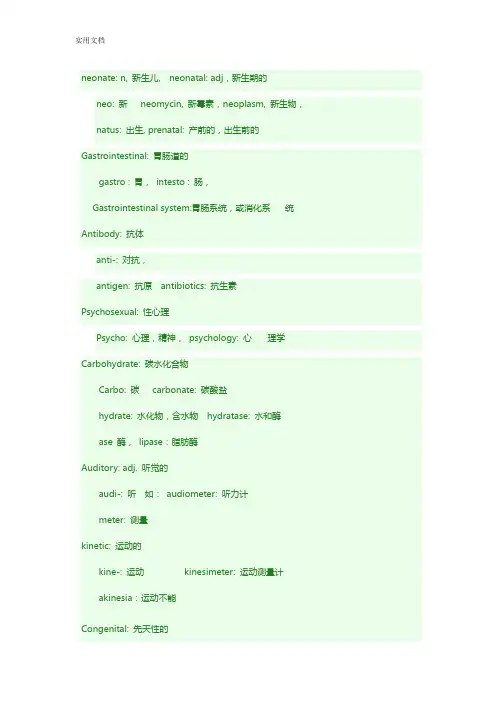
neonate: n, 新生儿, neonatal: adj,新生期的neo: 新neomycin, 新霉素,neoplasm, 新生物,natus: 出生, prenatal: 产前的,出生前的Gastrointestinal: 胃肠道的gastro : 胃,intesto : 肠,Gastrointestinal system:胃肠系统,或消化系统Antibody: 抗体anti-: 对抗,antigen: 抗原antibiotics: 抗生素Psychosexual: 性心理Psycho: 心理,精神,psychology: 心理学Carbohydrate: 碳水化合物Carbo: 碳carbonate: 碳酸盐hydrate: 水化物,含水物hydratase: 水和酶ase 酶,lipase:脂肪酶Auditory: adj. 听觉的audi-: 听如:audiometer: 听力计meter: 测量kinetic: 运动的kine-: 运动kinesimeter: 运动测量计akinesia:运动不能Congenital: 先天性的con- 和genitor-: 生殖,生殖器genitourinary:泌尿生殖的Defect:缺点,瑕疵de:否定,脱离,缺乏,不足degeneration:恶化fect:做infect:感染,影响Oxygenated: 含氧的,氧合的oxygen:氧气-ate:词尾,表示某种行为,状态Deoxygenate:去氧,脱氧de- 前缀,去离脱Unoxygenated:不含氧的,含氧低un-前缀,用于形容词之前,不Pulmonary:肺的pulmo-:肺pulmometer:肺量计Tachycardia: 心动过速tachy:快,迅速tachypnea:呼吸过快cardio-心脏Cardiovascular:心血管的Stenosis:狭窄steno-:狭窄stenocephaly:头狭窄,小头Hypertrophy:肥大,增生hyper:高于,超越,多于hypercardia:心肥大trophy:战利品,促,增加gonadotrophin:促性腺激素Hypotrophy:不足生长,萎hypo-:低于,少于,不足Cyanosis:发绀Acyanotic:不发绀的a-:不,没有anemia:贫血(-emia是血症)cyanotic:发绀的Hypoxia:低氧血症hypo(少)+ox(ygen)(氧气)+ia(血症)Dyspnea:呼吸困难dys-:前缀,困难dyskinesia:运动障碍pnea:气体,呼吸apnea:呼吸停止Leukemia: 白血病leuk- 同leuc-,白leucocyte:白细胞-emia-:同-hemia,血,血液Leukopenia:白细胞减少症-penia:血细胞减少thrombocytopenia:血小板减少症neutropenia:中性粒细胞减少症-neutro-:中,中间,中性neutrocyte:中性粒细胞Thrombocytopenia:血小板减少症-thrombo-:血小板,血栓thrombosis:血栓症thrombocyte:血小板-cyte:细胞erythrocyte:红细胞Infiltration: 渗透-in:向里filtrate:过滤,滤出Reticuloendothelia: 网状内皮reticulo-:网状的reticular:网状组织-endo-:内,内部endotrachea:气管内-theli-:乳头,皮瓣Chemotherapy:化疗chemo-: 化学的chemoanalysis:化学分析therapy:治疗Anesthetics:麻醉剂an-:前缀,否定的,相反的(同a-)-esthe-:感觉esthesia:感觉,感知Cystitis:膀胱炎cyst-囊,胞,膀胱cystalgia:膀胱痛-itis:炎gastritis:胃炎hemophilia 血友病hemo- 血,血液hemoglobin: 血红蛋白-phil: 亲,嗜neutrophil: 嗜中性白细胞neutron-: 中-ia: 词尾,表示—血症,petechia:淤血,淤点hemolyze: 溶血hemo-血-ly-:溶解fibrolysin: 纤维溶解素hemorrhage: 出血hemo- 血,血液-rrha-: 大量的流出diarrhea: 腹泻umbilical cord: 脐带umbil- 脐umbilectomy: 脐切除术cord 绳索,带子circumcision: 包皮环切术circum- 周围,环circumcorneal: 角膜周围(corneal 是角膜的意思)-cision 切开,切口incision:切割, 切开, 切口intracranial: adj 颅内的intra-: 内,内部intracellular: 细胞内的-cranio-: 颅的,颅骨的craniofacial: 颅面的laceration: 伤口,裂口lacer-: 撕裂lacerant:折磨人的,令人痛苦的hemarthrosis: 关节积血arthro-: 关节arthritis: 关节炎(-it is: 是炎症)-osis:词尾,疾病的状态petechia 瘀点,瘀斑peti:皮肤上的斑点impetigo:(皮肤)脓疱病-ia:词尾,血症anemia: 贫血an- 无,不,缺乏-emia:血症leukemia:白血病follow-up: 随诊,复诊immobilize: v 制动,不活动im-是前缀,同in,不,相反,没有mobile: 移动比如大家都熟悉的mobile phone: 移动电话antihemophili:抗血友病的anti- 对抗antiembolic:抗栓hemophilia 血友病degeneration 退化,变性de- 去,离,脱,除degrowth: 降低生长gene:基因,generation: 产生,发生, 生殖disability: 无能力,残疾dis-:分开,分离,否定,不disadjust:失调的able: 能,可以,ability: 能力,才干disable: 不能,disability: 残疾genetic: 遗传的gene: 基因hemolytic: 溶血性的hemo- 血,血液hemoglobin:血红蛋白-lyse-:溶解cytolysis: 细胞溶解precipitate:促成,使…陷入pre-:先于,…之前preplan:预先计划cipit:头dehydration:脱水de- 去,离,脱hydro-:水,含氢的hydrogen:氢Hematocrit:红细胞压积,红细胞比容hemato-:血液,血crit:同krites,判断Lethargy:无精打采,嗜睡les-:健忘的-argos-:懒散的Malaise:身体不适,不舒服,疲倦mal- 坏的,错误的malformation:畸形,难看-aise:同ease,悠闲,轻松,安逸Vaso-occlusion 血管堵塞vaso-:血管,输精管vasodilation:血管扩张occlusion:闭塞,阻塞Perfusion:灌注per-:通,穿透,支持,携带,向前fuse:熔化,合并,注入 infusion:灌输,输液Overheating:过热的over- 超过,高过,过分Pneumococcus:肺炎球菌pneumo-: 肺,气pneumonia:肺炎-coccus:球菌diplococcus:双球菌transfusion:输血trans-:转移transfer:转移,转让,传递fuse:合并,注入infusion:灌输,输液electrolyte:电解质electro-:电,电子的electroconvulsion:电击lyte:溶解Apnea: 无呼吸的,呼吸停止的a-:否定,相反的, 不,没有absent:缺席,不在-pnea-: 呼吸dyspnea:呼吸困难Bradycardia:心动过缓brady-:缓慢的bradypnea:呼吸过慢-cardio-:心脏cardigram:心电图Hypotonic:张力下降hypo-:少于,低于hypotension:低血压tonic:紧张的,张力的Autopsy:尸检auto-自己,自体autograft:自体移植物-opsis-:检查,看Bronchiolitis: 细支气管炎bronchio- 细支气管bronchiole: 细支气管-itis: 炎症meningitis: 脑膜炎Laryngitis: 喉炎laryngo- 喉laryngoscopy: 喉镜检查Laryngotracheobronchitis: 喉气管支气管炎-tracheo-: 气管tracheotomy: 气管切开术-broncho-: 支气管bronchitis: 气管炎Epiglottitis: 会厌炎epiglott-:会厌Syncytial: 合胞病毒的syn-: 共同,联合,相似synkinesia: 协同性运动, 辅助运动-cyto-: 细胞Hyperinflation: 过度膨胀hyper:高,过多hypertension:高血压-in-:相反的,否定的flat: 平坦的,扁的,漏气的Inspiratory: 吸气的in: 向内,进入insight:内在,见识-spirate-: 通气respiration: 呼吸Dysphagia: 吞咽困难dys- : 困难的-phago-: 吞咽,吞噬Phagocyte: 吞噬细胞Trecheostomy: 气管切开术-ostomy-: 切开术,造瘘术colostomy: 结肠造瘘术Epinephrine: 肾上腺素-epi-: 在…之上,在…之外epigastric:上腹部-nephro-: 肾脏的nephrosis: 肾病-ine: 素Corticosteroid: 皮质激素cortico-:皮,皮质corticose: 外皮的,皮层的steroid: 激素Endotracheal: 气管内的-endo-: 内,内部endocrine:内分泌Cystic 囊性的cyst-: 前缀表示“囊, 胞”之义cystectomy: 胆囊切除术Fibrosis: 纤维化,纤维变性fibr(o)- 纤维fibrocyte: 纤维细胞-cyte: 细胞-sis: --词尾,…化, …状态Dysfunction: 功能紊乱,机能不良dys: 困难dysphagia:吞咽困难Function: 功能Autosome: 常染色体,正染色体auto-自体,身体,自动-soma-: 体s omatic:肉体的Exocrine: 外分泌exo- 外部的exotoxin: 外毒素crinein: 分离Endocrine: 内分泌endo-: 内,内部endotoxin: 内毒素malabsorption: (营养)吸收不良mal-: 坏,错误,疾病malignant: 恶性的absorb: 吸收steatorrhea: 脂肪泻steato- 脂肪steatoma: 脂肪瘤-rrhea:大量流出diarrhea:腹泻expectorant:adj 化痰的,n 化痰剂ex-: 自…出来, 排出excrete: 排泄pector: 胸,胸腔mucolytics: 粘液溶解剂muco- 粘液mucoid: 粘液样的-lyte-: 溶解hemolysis: 溶血bronchodilator: 气管扩张剂broncho- 气管bronchitis: 气管炎dilate: 扩张dehydration: 脱水de- 前缀,去、脱hydro- 水,氢Prodromal :前驱的,有前驱症状的pro:居前,领先proenzyme:酶原dromos:跑,进行maculopapular:斑丘疹macule:斑疹papule:丘疹Centripetal: 向心的centro-:中心Antihistamine: 抗组胺药anti-:对抗antibody:抗体-histo-:组织histocyte:组织细胞-amine:胺Globulin:球蛋白globule:球,-in:素,酶,蛋白encephalitis:脑炎-encepho-:脑encephalopathy:脑病-itis:炎Paramyxovirus:副粘病毒para-: 副,旁,侧面parablast:副胚层-myxo-:粘,粘液myxocyte:粘液细胞virus:病毒Parotitis:腮腺炎,腮腺肿大Paroti-:腮腺,耳旁的parotin:腮腺激素Submaxillary:下颌的sub:下,亚,次subcutenous:皮下-maxill-: 颌Orchitis:睾丸炎-orcho-:睾丸orchotomy:睾丸切开术Epididymo-orchitis:附睾炎epididymo-:附睾teratogenic:产生畸形的-terato-:畸形teratosis:畸胎,怪胎Hydrogen peroxiede:过氧化氢,双氧水hydrogen:氢per-:携带,支持-oxide:氧化物dioxide:二氧化物Desquamation:脱皮,脱屑de-:去,脱,离squama:鳞片Arthralgia:关节痛-arthro-:关节arthritis:关节炎-gia:疼痛neuralgia:神经痛vasculitis:脉管炎,血管炎-vascul-:血管Hyperthermia:高热-thermo-:体温,热度thermometer:体温计Unremitting:不间断的un-:前缀,没有,不remit:宽恕,赦免Lymphadenopathy:淋巴腺疾病-lymph-:淋巴-adeno-:腺体adenoma:腺瘤Erythematous:红斑的-erythro-:红,红色Erythromycin:红霉素-ma:斑,瘤myoma:肌瘤Febrile:热性的febri-:发烧febricide:退热剂Conjunctivitis:结膜炎conjunctiva:结膜Oropharyngeal:口咽的-oro-:口Oral:口头的-pharyngo-:咽 Pharyngitis:咽炎Mucocutaneous:粘膜皮肤的-muco-:粘膜mucosa:黏膜-cutaneo-:皮肤subcutaneous:皮下的医学英语词根词缀记忆10Rheumatic: 风湿性的rheumato-:风湿rheumatoid: 类风湿的rheumatic fever: 风湿热Autoimmune: 自身免疫的auto-: 自身,自体autoantibody:自身抗体immune:免疫immune globulin:免疫球蛋白Streptococcus: 链球菌strepto-:链状的streptolysin: 链球菌溶血素streptomycin:链霉素-coccus: 球菌diplococcus:双球菌Peumococcus:肺炎双球菌Carditis: 心脏炎,心肌炎cardio-:心脏cardiovascular:心血管的myocardial:心肌的-itis:炎myocarditis:心肌炎Polyarthritis:多发性关节炎poly-: 多,多个,多种polycyte: 多型核细胞polyphagia:多食-arthro-: 关节arthrology: 关节学Erythema:红斑erythe: 红,红色erythromycin: 红霉素-ma: 肿物,斑myoma:肌瘤Subcutaneous: 皮下的Sub-: 在下;低于,次于,副,次Subadult:接近成年的人-cutan-: 皮肤percutaneous:经皮的ROM: Range Of Motion 环绕关节地运动,全关节运动Prophylactic:预防疾病的;预防性的pro-:在…之前-phylax-: 保卫phylaxin:抵抗素Glomerulonephritis:肾小球肾炎glomerulus :肾小球glomerulitis:肾小球炎glomerulopathy:肾小球病-nephro-:肾nephrocyte:肾原细胞nephrotoxicity: 肾毒性Bilateral:双侧的,有两面的bi-:两,双bipolar:双极的,两极的lateral:侧边unilateral:单侧的Noninfectious:非传染的non-:非,不,无nonabsorbable:不能被吸收的infectious:传染性的Streptococcus:链球菌strepto-:链状streptomycin:链霉素-coccus: 球菌diplococcus:双球菌Hypertension:高血压hyper:高于,多于h yperthermia:高温,发热tension:压力,张力Antihypertensive:抗高血压药anti:抗,对抗antibiotics:抗生素Retention:保留,储留Hematuria: 血尿Hemato-:血hematogenous:血源性的-uria:尿oliguria:少尿Integrity:完整,完全Specific gravity:比重Recurrence:复发,重现re-:再次retake:重摄reread:再读rewrite:再写-cur-:发生occur:发生,出现 concur:同时发生(con:共同)Otitis media: 中耳炎Otitis: 耳炎-oto-: 耳otophone: 助听器otolith:耳石-itis:炎Meningitis: 脑膜炎-meningo-: 脑膜meningocele: 脑膜膨出meningioma:脑(脊)膜瘤Eradicate: 根治,根除e-: 免,除去erase:抹去,擦掉-radic-: 根polyradiculitis:多神经根炎Decongestant:解充血药de-:去除,剥夺,脱离dehydration:脱水congest: 充血,充塞congestive heart failure:充血性心力衰竭-ant:药,剂absorbant:吸收剂Analgesic: 止痛的;镇痛剂an- : 无,没有,缺乏anacid:酸缺乏,无酸的anemia:贫血-algea-: 同algia,痛苦,感到痛苦neuralgia:神经痛Antipyretic:退热药anti-:抗antacid:抗酸剂antibacterial:抗菌的-pyreto-: 热pyretology: 热病学Myringotomy:鼓膜切开术-myringo-: 鼓膜myringitis: 鼓膜炎-otomy:切开术atriotomy:心房切开术Photophobia: 畏光-photo-: 光,相片phobia: 恐惧症acrophobia:恐高症basophobia:步行恐惧症Opisthotonos:角弓反张opistho-:后,体后 opisthion:颅后点,枕骨tonic:紧张,强直Multisystem:多系统的multi-:多,多种,多个 multiple:多样的,多重的Encephalopathy:脑病encephal-:脑encephalitis:脑炎-pathy:疾病neuropathy:神经病nephropathy:肾病持续更新,所需资料请私信,必尽最大努力尽快提供。
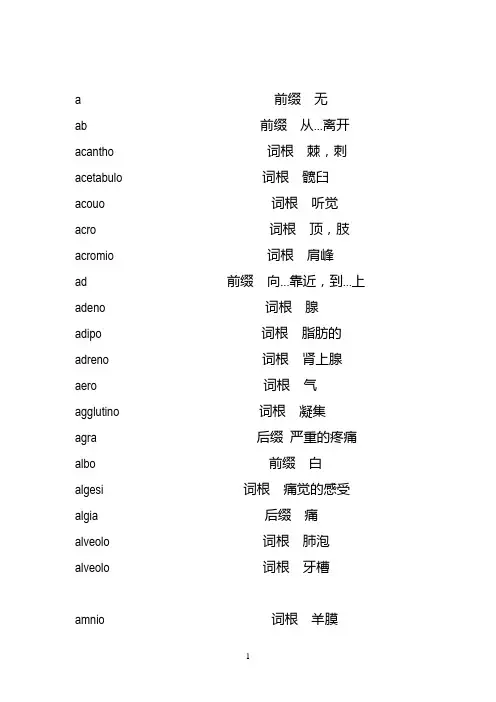
a 前缀无ab 前缀从...离开acantho 词根棘,刺acetabulo 词根髋臼acouo 词根听觉acro 词根顶,肢acromio 词根肩峰ad 前缀向...靠近,到...上adeno 词根腺adipo 词根脂肪的adreno 词根肾上腺aero 词根气agglutino 词根凝集agra 后缀严重的疼痛albo 前缀白algesi 词根痛觉的感受algia 后缀痛alveolo 词根肺泡alveolo 词根牙槽amnio 词根羊膜amphi 前缀两侧ampullo 词根壶腹amylo 词根淀粉an 前缀无ana 前缀向上,重回到andro 词根雄aneurysmo 词根异常扩大angino 词根阻塞ankylo 词根弯曲ano 词根肛门ante 前缀在前anti 前缀抗aorto 词根主动脉apico 词根顶apo 前缀离去,从appendico 词根阑尾appendo 词根阑尾aquo 词根水arterio 词根动脉arteriolo 词根小动脉arthro 词根关节articulo 词根关节ase 后缀酶astro 词根星atelo 词根不完全的,有缺陷的athero 词根脂肪堆积atrio 词根腔audio 词根听觉auro 词根耳auro 词根金auto 前缀自axio 词根轴balano 词根龟头bary 前缀重、压baso 词根碱bi 前缀双,倍bili 词根胆汁blast 后缀母细胞blenno 词根粘液blepharo 词根睑brachy 词根短bronchio 词根支气管bronchiolo 词根细支气管broncho 词根支气管bucco 词根颊bulbo 词根球部burso 词根滑液囊caco 词根坏calcaneo 词根跟骨calci 词根钙capillo 词根非常小的血管capnia 后缀二氧化碳carcino 词根癌carcinoma 后缀癌cardio 词根心carpo 词根腕cata 前缀向下cautero 词根燃烧ceco 词根盲肠cele 后缀突出、积水celio 词根腹cemento 词根牙骨质centesis 后缀穿刺术centi 前缀百分之一cerebello 词根小脑cerebro 词根大脑cerumino 词根耵聍cervico 词根颈cervico 词根颈,宫颈cheilo 词根唇chemo 词根化学chlorhydro 词根盐酸chloro 前缀绿chole 词根胆汁cholecysto 词根胆囊choledocho 词根总胆管chondro 词根软骨chorio 词根绒膜chromo 词根颜色cineo 词根活动circum 前缀环行clasis 后缀破裂clast 后缀破坏用器械claviculo 词根锁骨cleisis 后缀关闭clysis 后缀洗co 前缀与...在一起cocco 词根球菌coccygo 词根尾骨cochleo 词根耳蜗collo 词根胶colo 词根结肠colpo 词根阴道conjunctivo 词根结膜contra 前缀反,对抗coreo 词根瞳孔,虹膜corneo 词根角,角膜corono 词根冠costo 词根肋cranio 词根颅骨crine 后缀分泌cryo 词根冷crypto 词根隐藏culdo 词根囊袋、窝cuti 词根皮肤cyano 前缀蓝cyclo 词根环cyeso 词根妊娠cysto 词根膀胱,囊cyte 后缀细胞dacryo 词根眼泪dactylo 词根指头de 前缀去denti 词根牙齿dentino 词根牙本质dermato 词根皮肤dermo 词根皮肤di 前缀双,倍dia 前缀通过diaphoro 词根汗diaphragmato 词根膈diaphragmo 词根膈diplo 前缀双,倍dipso 词根渴dis 前缀离开duodeno 词根十二指肠dys 前缀坏,痛,困难ectasia 后缀扩张ectasis 后缀扩张ecto 前缀外ectomy 后缀切除术ego 前缀我embryo 词根胚胎emeo 词根呕吐emia 后缀血的状况emia 后缀血emphraxis 后缀梗阻en 前缀内encephalo 词根脑endo 前缀内部entero 词根小肠epi 前缀外,上epididymo 词根附睾epiglotto 词根会厌episio 词根外阴ergo 词根工作,能erythro 前缀红esophago 词根食道esthesio 词根感觉eu 前缀好,正常eustachio 词根咽骨管ex 前缀在外,离开exo 前缀在...之外extra 前缀在外,超过fasciculo 词根束fascio 词根筋膜febri 词根发热feca 词根粪便femoro 词根股骨fero 词根传递输送ferro 词根铁fibrino 词根纤维素fibro 词根纤维fibro 词根纤维fibulo 词根腓骨fistulo 词根瘘folliculo 词根小腔,囊galacto 词根乳gameto 词根配子ganglio 词根神经节gangliono 词根神经节gastro 词根胃genito 词根生殖器gero 词根年龄geronto 词根年龄geusia 后缀味gingivo 词根牙glauco 前缀灰绿glio 词根胶质,粘globo 词根球glomerulo 词根小球glosso 词根舌gluco 词根糖glyco 词根糖gnatho 词根颌gnosis 后缀知识gonado 词根性腺gono 词根生殖器gram 后缀记录granulo 词根结节graph 后缀记录graphy 后缀记录gravido 词根妊娠gyneco 词根女性halo 词根盐haplo 前缀单hebe 前缀青年hecto 前缀百helcosis 后缀溃疡形成hemato 词根血hemi 前缀半hemo 词根血hepato 词根肝hernio 词根疝hidro 词根汗histo 词根组织holo 词根整个humero 词根肱骨hyalo 词根透明的hydro 词根水hyper 前缀超过,高hypno 词根睡眠hypo 前缀低hystero 词根子宫ia 后缀状况iatrics 后缀愈合iatry 后缀愈合ictero 词根黄疸idio 词根自己ileo 词根回肠ilio 词根髂骨immuno 词根免疫in 前缀在内in 前缀不in 后缀素incudo 词根砧骨infra 前缀在下ino 词根纤维inter 前缀在...之间intra 前缀在内iono 词根离子ionto 词根离子irido 词根虹膜iro 词根虹膜ischio 词根坐骨ism 后缀状况iso 词根异,相等ist 后缀者itis 缀炎ium 后缀部分jejuno 词根空肠kal 词根钾karyo 词根核kerato 词根角质,硬kerato 词根角膜kilo 前缀千kinesia 后缀移动kleisis 后缀关闭klepto 词根偷窃kypho 词根驼背labio 词根唇labyrintho 词根迷路lacrimo 词根眼泪,泪小管lalia 后缀言语lamino 词根椎板laparo 词根腹壁laryngo 词根喉leuko 前缀白linguo 词根舌lipo 词根脂肪lithiasis 后缀结石litho 词根石lobo 词根叶logist 后缀学者logy 后缀学科lordo 词根弯曲luco 词根光,透明lumbo 词根腰lympho 词根淋巴lysis 后缀溶解malacia 后缀软化malleo 词根锤骨mammo 词根乳房mandibulo 词根下颌骨mania 后缀极端、强制、偏见masto 词根乳房maxillo 词根上颌骨mediastino 词根纵隔mega 词根大megalo 词根大melano 前缀黑meningio 词根脑膜meningo 词根脑膜meno 词根月经mento 词根颏mento 词根精神、心理mero 词根部分mesentero 词根肠系膜meso 词根中间的meta 前缀超过,在后metacarpo 词根掌骨metatarso 词根柘骨meter 后缀测量工具metro 词根子宫metry 后缀测量micro 词根微milli 前缀千分之一mono 前缀单muco 词根粘液multi 前缀多musculo 词根肌肉muto 词根变化,突变myco 词根真菌myelino 词根髓myelo 词根脊髓,骨髓myo 词根肌肉myoso 词根肌肉myringo 词根耳鼓myxo 词根粘液narco 词根麻木naso 词根鼻natri 词根钠necro 词根死亡neo 词根新nephro 词根肾neuro 词根神经nigro 前缀黑nodo 词根结nucleo 词根核obstetrico 词根产科occluso 词根牙(牙合)oculo 词根眼odonto 词根牙齿odynia 后缀痛oid 后缀象...样的olecrano 词根肘oligo 词根少oma 后缀瘤omento 词根网膜omphalo 词根脐onco 词根肿瘤,块onycho 词根甲,甲床ooo 词根卵子oophoro 词根卵巢ophthalmo 词根眼opia 后缀视觉or 后缀器具,者orchido 词根睾丸orchio 词根睾丸orexi 词根食欲oro 词根口orrhagia 后缀大量流出orrhaphy 后缀缝合术orrhea 后缀流出、分泌orrhexis 后缀破裂ortho 词根直的osis 后缀病理状况osteo 词根骨ostomy 后缀造口或吻合oto 词根耳ous 后缀含...的,分泌...的ovario 词根卵巢ovo 词根卵子oxo 词根氧oxy 词根氧palato 词根腭pallio 词根减轻palpebro 词根睑pancreato 词根胰腺papillo 词根乳头状突起par(t)o 词根娩出para 前缀旁,异parasympathetico 词根副交感parasympathico 词根副交感parasympatho 词根副交感parathyroido 词根甲状旁腺patello 词根髌骨pathy 后缀病理状况pectoro 词根胸pelvo 词根骨盆penia 后缀不足peno 词根阴茎pento 前缀五pepsi 词根消化pepti 词根消化per 前缀通过peri 前缀周围perineo 词根会阴peritoneo 词根腹膜pexy 后缀固定phaco 词根晶体phago 词根吞噬phalango 词根指骨phallo 词根阴茎pharmaco 词根药pharyngo 词根咽pharyngo 词根咽philo 词根嗜phlebo 词根静脉phobia 后缀害怕photo 词根光,透明phrenia 后缀精神、心理phrenico 词根膈神经phreno 词根膈phylaxis 后缀保卫physis 后缀生长pilo 词根毛发pinealo 词根松果体plasia 后缀形成plasm 后缀形成的东西plasmo 词根浆plasty 后缀成形plegia 后缀麻痹pleuro 词根胸膜pnea 后缀呼吸pneumo 词根气,肺pneumono 词根气,肺podo 词根足poiesis 后缀产生polio 前缀灰白poly 前缀多polypo 词根息肉post 前缀在后pre 前缀在前pro 前缀在后procto 词根肛门和直肠pros 前缀到,靠近,附上prostato 词根前列腺prostho 词根假牙,义肢pseudo 词根假psycho 词根精神、心理ptosis 后缀下垂ptyalo 词根唾液ptyo 词根唾液pubio 词根耻骨pubo 词根耻骨pulmo 词根肺pulmono 词根肺pyelo 词根肾盂pyloro 词根幽门pyo 词根脓pyro 词根热quadri 前缀四quarto 前缀四rachio 词根脊柱radico 词根根治radio 词根桡骨radio 词根放射ramo 词根分支recto 词根直肠reno 词根肾reticulo 词根网retino 词根视网膜retro 词根向后rhino 词根鼻roentgeno 词根X线rub 前缀红saccharo 词根糖sacro 词根骶骨saliva 词根唾液salpingo 词根管salpingo 词根管,输卵管sarco 词根肉sarco 词根肉瘤sarcoma 后缀肉瘤scapulo 词根肩胛schesis 后缀抑制排出schizo 词根分裂schizo 词根分裂sclero 词根巩膜sclerosis 后缀硬化scolio 词根弯曲scope 后缀镜scopy 后缀镜检查scroto 词根阴囊sebo 词根油脂seco 词根切semi 前缀半semino 词根精子septo 词根腐败sero 词根血清sialadeno 词根唾液腺sialo 词根唾液sidero 词根铁sigmoido 词根乙状结肠silico 词根硅sino 词根窦somato 词根体somni 词根眠sono 词根声sopori 词根沉睡spasmo 词根痉挛spermato 词根精子spermo 词根精子sphinctero 词根括约肌sphygmo 词根脉搏spino 词根脊髓spiro 词根呼吸splanchno 词根内脏spleno 词根脾spondylo 词根椎骨stapedo 词根镫骨staphylo 词根束stasis 后缀制止、停止stasis 后缀停止steato 词根脂肪stenosis 后缀狭窄stereo 词根立体sterno 词根胸骨stero 词根固stetho 词根胸stomato 词根口sub 前缀在下submaxillo 词根下颌骨succo 词根分泌sudoro 词根汗super 前缀在上supra 前缀高于surgery 后缀外科surgico 词根外科sympathetico 词根交感sympathico 词根交感sympatho 词根交感syn 前缀合成syndesmo 词根韧带synovio 词根滑液syringo 词根瘘管tacho 词根快速talo 词根踝,距骨tarso 词根踝,跗骨taxis 后缀排列tel 词根远的tele 词根远的tendino 词根腱tendo 词根腱teno 词根腱terato 词根畸胎testo 词根睾丸tetra 前缀四thalamo 词根丘脑therapy 后缀治疗thio 词根硫thoraco 词根胸thrombo 词根凝thymo 词根胸腺thyro 词根甲状腺thyroido 词根甲状腺tibio 词根胫骨toco 词根出生,分娩tome 后缀切开器具tomy 后缀切开术tono 词根紧张度tono 词根紧张tonsillo 词根扁桃体topo 词根地方toxico 词根毒toxo 词根trachelo 词根子宫颈tracheo 词根气管trans 前缀通过,穿过tri 前缀三tricho 词根毛发triplo 前缀三tripsy 后缀压碎tropin 后缀激素tubulo 词根小管tumo 词根肿瘤,肿胀tussi 词根咳嗽tympano 词根鼓室ulno 词根尺骨ultra 前缀超umbilico 词根脐unguo 词根甲,爪uni 前缀uretero 词根输尿管urethro 词根尿道uria 后缀尿uro 词根尿utero 词根子宫utriculo 词根小囊uvulo 词根悬雍垂vagino 词根阴道vago 词根迷神经valvo 词根瓣varico 词根扭曲的静脉vaso 词根血管vaso 词根输精管veno 词根静脉ventriculo 词根脑室ventro 词根腹侧venulo 词根小静脉verruco 词根疣vertebro 词根椎骨vesico 词根膀胱vesiculo 词根精囊vestibulo 词根中耳的中部viro 词根病毒vito 词根生命vulvo 词根外阴xantho 前缀黄zoo 词根生物。
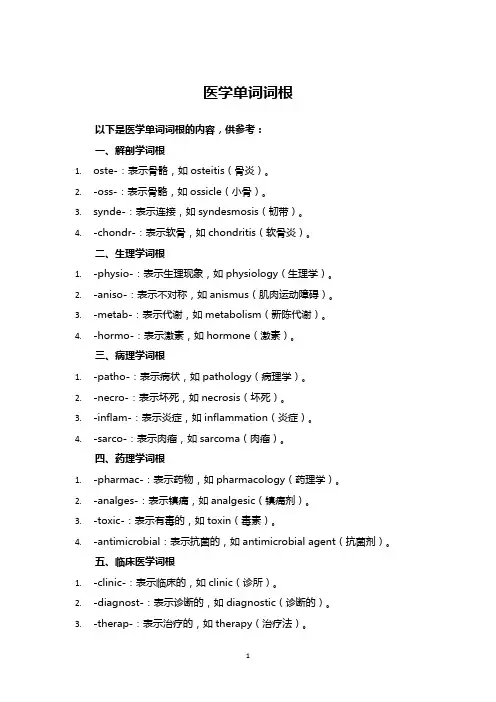
医学单词词根以下是医学单词词根的内容,供参考:一、解剖学词根1.oste-:表示骨骼,如osteitis(骨炎)。
2.-oss-:表示骨骼,如ossicle(小骨)。
3.synde-:表示连接,如syndesmosis(韧带)。
4.-chondr-:表示软骨,如chondritis(软骨炎)。
二、生理学词根1.-physio-:表示生理现象,如physiology(生理学)。
2.-aniso-:表示不对称,如anismus(肌肉运动障碍)。
3.-metab-:表示代谢,如metabolism(新陈代谢)。
4.-hormo-:表示激素,如hormone(激素)。
三、病理学词根1.-patho-:表示病状,如pathology(病理学)。
2.-necro-:表示坏死,如necrosis(坏死)。
3.-inflam-:表示炎症,如inflammation(炎症)。
4.-sarco-:表示肉瘤,如sarcoma(肉瘤)。
四、药理学词根1.-pharmac-:表示药物,如pharmacology(药理学)。
2.-analges-:表示镇痛,如analgesic(镇痛剂)。
3.-toxic-:表示有毒的,如toxin(毒素)。
4.-antimicrobial:表示抗菌的,如antimicrobial agent(抗菌剂)。
五、临床医学词根1.-clinic-:表示临床的,如clinic(诊所)。
2.-diagnost-:表示诊断的,如diagnostic(诊断的)。
3.-therap-:表示治疗的,如therapy(治疗法)。
4.-prophylaxis:表示预防的,如prophylaxis(预防措施)。
六、疾病名称词根1.-encephal-:表示脑部疾病,如encephalitis(脑炎)。
2.-cardio-:表示心脏疾病,如cardiology(心脏病学)。
3.-nephro-:表示肾脏疾病,如nephritis(肾炎)。
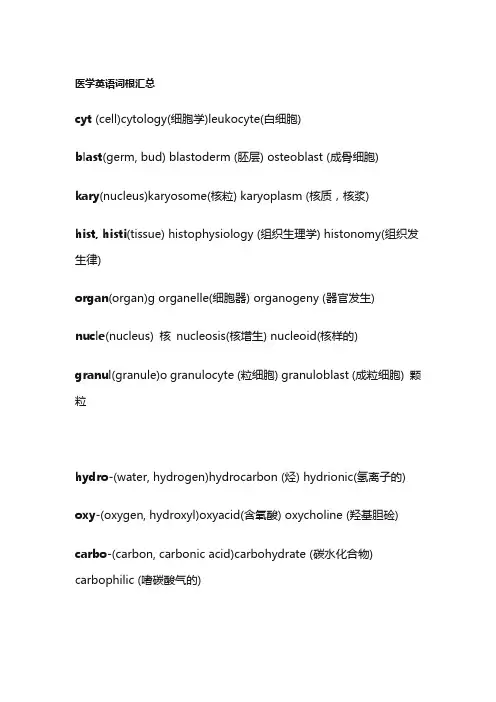
医学英语词根汇总cyt (cell)cytology(细胞学)leukocyte(白细胞)blast(germ, bud) blastoderm (胚层) osteoblast (成骨细胞)kary(nucleus)karyosome(核粒) karyoplasm (核质,核浆)hist, histi(tissue) histophysiology (组织生理学) histonomy(组织发生律)organ(organ)g organelle(细胞器) organogeny (器官发生)nucle(nucleus) 核nucleosis(核增生) nucleoid(核样的)granul(granule)o granulocyte (粒细胞) granuloblast (成粒细胞) 颗粒hydro-(water, hydrogen)hydrocarbon (烃) hydrionic(氢离子的) oxy-(oxygen, hydroxyl)oxyacid(含氧酸) oxycholine (羟基胆硷)carbo-(carbon, carbonic acid)carbohydrate (碳水化合物) carbophilic (嗜碳酸气的)nitro-(nitrogen,NO group)nitrobenzol (硝基苯) nitrogenous (含氮的)chloro-(chlorine) chlorination (氯化作用)tetrachloride (四氯化物)sulfo-sulpho-(sulfur)sulfonamide (磺胺)sulfoxide(硫氧化物)phospho-( phosphorus)phosphopenia (磷质缺少)phosphokinase (磷酸激酶)fluoro-(fluorine) fluoridation (加氟作用)fluorosis(氟中毒)iodo-(iodine)iodometry(碘定量法)iodite(亚碘酸盐)natri-(sodium)naturemia(钠血症)natriuresis (尿钠排泄)kali-(potassium) hyperkaliemia (高钾血)calci-, calco-(calcium) calcibrivic (缺钙的)calcophorous (含钙的)chromo-(color) chromosome (染色体) chromoscope (色觉检查器) erythro-(red) erythroblast (成红细胞) erythromycin (红霉素).leuko-, leuco-(white)。
基础词根(20个)汉义英词希腊源拉丁源例词前before pro- pre- prognosis (预后) / precardiac (心前的)上above hyper-, epi- super- epigastrium(上腹部) /superofrontal (额上的)下below hypo- sub- hypotension(低血压)/ subneural(神经下的) 内inside endo- intra- endocrine(内分泌的)/ intervenous(静脉内的)多many, much poly- multi- polyuria(多尿症)/ multipara (经产妇)同sameness homo- iso- homobody(同体)/ isotope (同位素)异difference allo- hetero- allosome(异染色体)/ heterotopia(异位)半half hemi- semi- hemisection(半切除)/ semicanal (半管)一one mono- uni- monoclonal(单克隆的)/ unicellular (单细胞的)二two di- bi- diarthric(两关节的)/ bidental(双牙的)运动系统(10个)汉义英词希腊源拉丁源例词肌肉flesh myo- musculo- myofiber(肌纤维)/ musculotendinous(肌腱的)骨bone osteo- os- osteoporosis(骨质疏松)/ ossa pedis (足骨)关节joint arthro- articulo- a rthritis(关节炎)/ articulation (关节)椎骨vertebra spondylo- vertebro- spondylodynia脊椎痛/ vertebrocostal(椎肋的)脊柱backbone rachio- spino- rachiomyelitis(脊髓炎)/ spinocortical(脊髓皮质的)心血管系统(10个+备用8个)汉义英词希腊源拉丁源例词心heart cardio- cor- cardiology(心脏病学)/ cor bovinum (牛心症)心房atrium atrio- aurico- atrium(心房)/ auricula (心房)血blood hemo- hemato- hemoglobin(血红蛋白)/ hematology (血液学)血管vessel angio- vaso- angiofibroma(血管纤维瘤)/ vascular (血管的)静脉vein phlebo- veno- phlebology(静脉学)/ venoclysis (静脉输注)快fast tachy- tachycardia (心动过速)慢slow brady bradycardia (心动过缓)主动脉aorto------- main artery毛细血管capillo------slim vessel血栓thrombo--------clot of blood血清sero-------watery part of blood.淋巴lympho-----colorless fluid from the tissues or organs of the body,containing white-cells.胸腺thymo-----a kind of gland in chest.呼吸系统(6个+ 备用5个)汉义英词希腊源拉丁源例词呼吸breath pneumo- spiro- pneumocardiography(呼吸心动描记法)/ spirography(呼吸描记法)鼻nose rhino- naso- rhinoplasty(鼻整形术)/ nasolabial (鼻唇的)肺lung pneumono- pulmo- pneumonia (肺炎)/ pulmonologist (肺脏病学家)咽pharyngo----喉laryngo------the hollow box like part in your throat where you make voice sounds气管tracheo----wind-pipe支气管broncho----slim windpipe胸膜pleuro----delicate membrance of the thorax and the lungs.呼吸-pnea -----breathe消化系统(第一组10个;第二组10个;备用7个)汉义英词希腊源拉丁源例词消化digestion pepso- gesto- pepsin(胃蛋白酶)/口mouth stomato- oro- stomatology(口腔医学)/ oronasal(口鼻的)舌tongue glosso- linguo- glossocele(大舌病)/ lingular (小舌的)牙teeth odonto- dento- odontoma(牙瘤)/ dentist(牙医)肝liver hepato- jeco- hepatization(肝样变)/ jecorize (鱼肝油化)胆gall bladder chole- bili- cholecyst(胆囊)/ biligenensis(胆汁生成)肠gut entero- intestino- enterococcin(肠球菌素)/ intestinotoxin(肠毒素)直肠rectum procto- recto- proctectomy (直肠切除术)/ rectum (直肠)肛门anus procto- ano- proctodynia(肛部痛)/ anus (肛门)糖glucose glyco- saccharo- glycogen(糖原)/ saccharose (蔗糖)食道esophago-胃gastro-幽门pyloro-阑尾appendo-胆囊cholecysto-胰腺pancreato-酶-ase泌尿系统(6个+4个= 10个)汉义英词希腊源拉丁源例词肾kidney nephro- reno- nephrosis(肾变病)/ renocortical (肾皮质的)肾盂renal pelvis pyelo- pelvi- pyelopathy(肾盂病)/ pelviostpmy(肾盂造口术)膀胱bladder cysto- vesico- cystotome(膀胱刀)/ vesicocolic(膀胱结肠的)尿urine uro- urocyst (膀胱)水water hydro- hydromyelia (脊髓积水)球菌coccus cocco- coccobacillus(球杆菌)结石stone litho- litholysis(结石溶解)皮肤、感觉器官(6个)汉义英词希腊源拉丁源例词皮肤skin dermato- cutaneo- dermatitis(皮炎)/ cutaneomucosal(皮粘膜的)眼eye ophthalmo- oculo- ophthalmosurgery(眼外科)/耳ear oto- auri- otology(耳科学)/ auriform(耳状的)药理学(2个)汉义英词希腊源拉丁源例词药drug pharmaco- medicine pharmacogenetics(药物遗传学)疗法treatment -therapy remedy chemotherapy(化疗)诊断(7个)汉义英词希腊源例词表,量器measure -meter thermometer (温度计)度量,测量to measure -metry pelvimetry (骨盆测量法)图,像 a mark -gram electrocardiogram (心电图)图-graph electrocardiograph (心动电流描记器)书写,记录to write -graphy electrocardiography (心动电流描记法)镜to examine -scope endoscope (内镜)检查法to examine -scopy endoscopy (内镜检查术)外科学(6个)汉义英词希腊源例词切开cutting -tomy anatomy (解剖)切除cut away -ectomy appendectomy (阑尾切除术)造口opening -stomy gastrostomy (胃造口术)成形shape -plasty cardioplasty (贲门成形术)缝合sew -rrhaphy herniorraphy (疝缝手术)固定术fixation -pexy hepatopexy (肝固定术)典型词素(第一组10个;第二组9个)情况-ia anoxia (缺氧症)瘤-oma carcinoma (癌)炎症-itis hepatitis (肝炎)痛-algia arthralgia (关节痛)痛-dynia osteodynia (骨痛)血症-emia leukemia (白血病)尿-uria oliguria (少尿症)病态,状态-osis sclerosis (硬化症)贫乏,缺少-penia erythropenia (红细胞减少)患病状态,疾病-pathy myopathy (肌病)细胞cell -cyte monocyte (单核细胞)体-some chromosome(染色体)嗜-phil acidophilia (嗜酸性)杀死-cide g ermicide(杀虫剂)溶解-lysis hemolysis (溶血)溢出-(o)rrhea diarrhea(腹泻)恐惧-phobe hydrophobia(恐水症)…学科-iatry/ -iatrics pediatrics (儿科)..状的-form filiform (线形的)成…细胞-blast osteoblast (成骨细胞)。
医学英语词根
1. -cardio-:与心脏有关,如-cardiology(心脏病学)。
2. -dermat-:与皮肤有关,如-dermatology(皮肤病学)。
3. -gastro-:与胃有关,如-gastroenterology(胃肠病学)。
4. -hepat-:与肝脏有关,如-hepatology(肝脏病学)。
5. -neuro-:与神经有关,如-neurology(神经病学)。
6. -patho-:与疾病有关,如-pathology(病理学)。
7. -pedi-:与儿童有关,如-pediatrics(儿科学)。
8. -psycho-:与心理有关,如-psychiatry(精神病学)。
9. -surg-:与手术有关,如-surgery(外科学)。
10. -ortho-:与正直、正确有关,如-orthopedics(矫形外科学)。
这只是一小部分常见的医学英语词根,还有很多其他词根。
通过了解这些词根,我们可以更容易地理解和记忆医学英语词汇,并提高我们在医学领域的英语水平。
前缀1. cor- or cardi(o)- 心的 heart--- cordiform 心形的 ---cordate心脏形的 --- cardialgia 心痛 --- cardiogram心电图2. hepato- pref肝 liver--- hepatodynia 肝痛 --- hepatoma肝细胞瘤--- hepatopathy肝病 --- hepatotoxin肝毒素3. pulmo- or pneumo- or pneumat(o)- 肺 lung or air --- pulmometry肺容量测定法 --- pulmonitis 肺炎--- pneumobacillus 肺炎杆菌--- pneumonectasis 肺气肿--- pneumatolysis 肺气化--- pneumatometer 肺活量计4. lien(o)- or spleen(o)-脾 splee---lienitis 脾炎--- lienectomy 脾切除--- splenotomy 脾切开术 --- splenomegaly 脾肿大5. ren(o)- or nephr(o)- kidney--- renin 肾索--- renography肾X线照相术---nephritis肾炎 --- nephrolithiasis肾石病6. oro- or stomat(o)- mouth--- oropharynx 口咽--- oronasal口鼻的--- stomatology 口腔病学 --- stomatitis 口腔炎7. labio- or cheil(o)- lip--- labiodental唇齿音--- labioplasty唇成形术cheilectropion唇外翻 cheiloschisis唇裂8. denti- or odonto- pref. tooth-- dentist--- dentiscalprum牙刮---odontoprosthesis 牙体修复术—odontoseisis牙松动9. linguo- tongue--- lingua舌—linguiform舌装的--- lingulate 舌装的--- linguodental舌齿音10. gingiv- or ulo- 牙龈 gum---gingivectomy龈切除术—gingivitis齿龈炎---ulorrhagia龈出血---ulorrhoea 龈糁血11. palato- or urano- 腭 palatine---palatitis腭炎---palatogram口盖图---palatograph腭动扫描器palatography腭位图的制作12. pharyngo- 咽 pharynxpharyngalgia咽痛pharyngocele咽囊肿pharyngoplasty咽成形术pharyngoplegia咽肌麻痹13. laryngo- 喉 larynx,throatLaryngalgia喉痛laryngemphraxis喉阻塞laryngostenosis喉狭窄laryngoxerosis喉干燥14. esophag(o)- 食管 esophagusEsophagectasis食管扩张esophagectopy食管异位esophagocele食管突出 esophagotomy食管切开术15. gastr(o)- stomachgastrin 胃泌激素gastrectasia胃胀gastroanastomosis胃吻合术gastroptosis胃下垂16. enter(o)-肠 intestineenterelcosis 肠溃疡enteremphraxis肠阻塞enterorrhagia肠出血enterocolostomy 小肠结肠吻合术17. colo- or coli- or col- pref结肠. coloncolicodynia 结肠痛colimycin结肠霉素coloclysis结肠灌洗 colonorrhea粘液性结肠炎(o)- or archo-直肠 rectumProctectomy直肠切除术proctitis 直肠炎proctoscope直肠镜- proctoscopy直肠镜观察术肛门 anusAnogenital肛门与生殖器的anorectal肛门直肠的anorectum肛门直肠部anoscope肛门镜20. vesico- or cysti- or cysto- 膀胱 bladderVesicotomy膀胱切开术cystirrhagia膀胱出血cystocele 膀胱彭出cystourethritis膀胱尿道炎21. thoraco- chest or 胸 thoraxThoracocyllosis胸畸形thoracicolumbar 胸腰的thoracoschisis 胸裂thoracoplasty胸廓成形术22. ventro- or coeli(o)- or laparo- 腹部 belly、abdomenVentrotomy剖腹术coelialgia腹痛Coeliorrhaphy 腹腔缝术laparotome剖腹术23. bili- or chole-胆 bilebilichol 胆汁醇- biligenic生胆汁的cholecyst 胆囊cholelithiasis胆石病24. oculo- or ophthalmo- eyeoculist 眼科医生oculomotor 眼球运动的ophthalmoplegia眼肌麻痹ophthalmoscope检眼镜25. lacrimo- or dacryo-眼泪 tearlacrimator 催泪物质-lacrimal 泪腺的lacrimatory agent催泪剂lacrimation 泪26. palpebro- or blepharo-眼睑 eyelid palpebra 眼睑palpebral 眼睑的blepharochalasis 眼睑皮肤松弛症 blepharospasm眼睑痉挛27. kerato-角角质 horn or comeakeratectasia 角膜膨胀keratinase 角蛋白酶keratoplasty 角膜成形术keratosis角化症or oto- earauriphone 助听器auristilla滴耳剂 otorrhea耳液溢,耳漏 otosclerosis 耳硬化症or rhino- noseNasitis鼻炎nasopharynx 鼻咽 rhinocleisis鼻腔闭塞rhinocnesmus 鼻痒or bronch- 支气管 pref. bronchus; bronchial Bronchiectasis支气管扩张bronchiolitis细支气管炎 bronchorrhagia支气管出血bronchospasm支气管痉挛31. gonado- 生殖腺 seedGonadectomy性腺切除术gonadotrophin 促性腺激素gonadotrope 生殖腺32. andro- 男的雄性的 maleandrocentrism大男子主义androgen 雄激素andrology 男科学 androsterone 雄淄酮33. gyne- or gyneco- femaleGynecic女性的gynecium 雌蕊雌蕊群gynecologist 妇科医生gynecopathy 妇科病34. vagino- or colpo- 阴道 vaginaVaginectomy阴道切除术vaginotomy阴道切开术colpoptosis阴道下垂colporrhaphy阴道缝合术35. oophor- 卵巢 ovaryOophorectomy卵巢切除术oophorectomize切除。
Ⅱ前缀Post-后postpartum产后De-去dehydration脱水Hyper-高hyperuricemia高尿酸血症Pre-前premature发生在适当时间之前的Myo-肌myoglolinemia肌红蛋白血症Tetra-四tetrachloride四氯化Re-重复Replicate复制Poly-多Polymerase聚合酶Deoxy-脱氧Deoxyribonucleotide脱氧核糖核苷酸Trans-转移Transferase转移酶di-二Phosphodiester磷酸二酯Pro-原proinsulin胰岛素原Tachy-快Tachycardia心动过速Lipo-脂Lipophilic亲脂的Hydro-水Hydrophilic亲水的Entero-肠Enterohepatic肠肝的Ar-非;失常Arrhythmogenic致心律失常的bi-二Bigeminy二联律Dis-缺乏Disorientation定向力缺乏Auto-自动automaticity自律性Extra-外extracellular细胞外的Non-非nontraumatic非创伤性的Epi-上epigastrium上腹部的Peri-周围periumbilical脐周Para-旁paracolic结肠旁Hemat-血hematemesis呕血Intra-内intramural壁内的Ipsi-同ipsilateral同侧的Oro-口oropharynx口咽部Hepato-肝hepatosplenomegaly肝脾肿大Dys-困难dyspneic呼吸困难的Brady-过缓bradycardia心动过缓Naso-鼻nasopharygeal鼻咽的Encephalo-脑Encephalomenigitis 脑膜脑炎Myo-肌myocarditis心肌炎Gastro-胃gastroenteritis胃肠炎Ovi-卵oviduct输卵管Endo-内endometrium子宫内膜Radio-放射radioimmunoassay放射免疫测定Nulli-未nullipara未产妇a-无、非amenorrhea闭经-ectomy切除术hysterectomy子宫切除术Bronchi-支气管bronchiectasis支气管扩张Neo-新neoplasm新生物Lympho-淋巴lymphoma淋巴瘤Tetra-四tetracycline四环素Hypo-低hypogammaglobulinaemia低γ-球蛋白血症Micro-微microangiopathy微血管病变Retino-视网膜retinopathy视网膜病变后缀-megaly肿大hepatosplenomegaly肝脾肿大-centesis穿刺术thoracentesis胸腔穿刺术-emia血症hyperuricemia高尿酸血症-itis炎症pancreatitis胰腺炎-ase酶Transferase转移酶-lysis分解proteolysis蛋白分解-philic亲Lipophilic 亲脂的-genic致arrhythmogenic致心律失常的-rrhea溢galactorrhea溢乳-stasis稳定homeostasis体内环境稳定-scopy镜检查laparoscopy腹腔镜检查-otomy切开术colpotomy阴道穹隆切开术-pathy病变retinopathy视网膜病变-ist者、专家ophthalmologist眼科医师解剖:解剖学术语前缀含义举例a-an- 不;不是;非;没有;少azygos: 不成对的部分;无对偶的部分;单一器an tibacterial: 抗生素ante- 在…之前;…前的antecubital: 肋前的anti- 反抗;治疗的 anti bacterial: 抗生素circum- 环;周围 circum ferential fibers: 环型纤维contra- 反抗;逆对 contra lateral: 对侧的ec-出;偏离 ec ctopic: 异位的endo- 内部的;内在的 endoscope: 内窥镜epi- 在上;向 epi dural: 硬膜的ex- 出;从;来的 ex cise: 切除extra-天;…外的 extradural: 硬膜外的hyper- 过好的;超出平常的hyperlordosis: 过度前凸ermal pertaining to upon the skinhypo- 不足的;在…下的 hypokyphosis: 后凸平足;平背畸形infra-在…下 infra laminar: 椎板下节inter- 在…之间 intercostal: 肋间intra- 在…之内 intradural: 硬膜下ipsi- 相同的 ipsi lateral: 同侧的mal- 病态的;平启的 mal union: 骨接合不正medi- 中间的 medi al: 中间的para- 不正常的;延…的;附近的para esthesiaor paresthesia: 感觉异常peri- 围绕;附近的 peri neural: 神经外膜post- 之后;在…后 post operative: 术后的pre- 之前;在…前 preoperative:术前准备pseudo- 假的 pseudoarthrosisor pseudarthr-osis: 假关节retro- 向后;回复 retro peritoneal: 腹膜后的semi- 半 semi lunar: 半月型的sub- 之下;在…之下 subcutaneous: 皮下的supra- 之上 supralaminar: 椎板上syn- 共;合 syn ostosis: 骨连接trans- 穿过 trans peritoneal: 经腹膜常用后缀-algia 疼痛 arthralgia: 关节痛-clasis 断;折断 osteoclasis: 骨破折-desis 固定关节或骨头 arthrodesis: 关节固定术关节融合术-ectomy 切除 laminectomy: 椎板切除术-emia 血 anemia: 贫血-genesis 形成;起源 osteogensis: 骨发生-itis 炎症 arthitis: 关节炎-lysis 分解;松解 osteolysis: 骨吸收 ; 骨质溶解-malacia 软化 chrondromalacia: 轻骨软化-oid 类似 osteoid: 骨样的-oma 肿瘤 sarcoma: 肉瘤-otomy 切;截 osteotomy: 截骨术-paresis 半;部分麻痹 hemiparesis: 半身麻痹-pathy 病 neuropathy: 神经病肥大-penia 不止;减少 osteopenia: 骨质减少-plasia 生长;形成 hyperplasia: 增生;过度增生-plasty 手术修复 cranioplasty: 颅骨成形术-scope 检查设备 thoracocscope: 胸腔镜-scopy 用设备检查 thoracoscopy: 胸腔镜检查-stenosis 狭窄的 spinal stenosis: 椎管狭窄-tome 切割器械 ostetome: 骨力-tomy 切;截 osteotomy: 截骨术-trophy 食物;营养 hypetrophy: 过度生长常用的前缀第一节表示无;抗;非的前缀一.a-;an-无;非..无可以进一步理解为离开;除去;脱去等1.无abacteria 无菌的;atony 无力;anemia 贫血无血之意..Abiosis 无生命;abraehia 无臂畸形;adaerya 无泪;asaetylia 无指趾畸形;asendrie 无树突的;adermotrophia 皮肤萎缩即无皮肤营养之意;adiaphoresis 无汗症..2.否定asymmetercal 不对称的;asynergy 不协调;astnthests 不连接;aststole 心搏停止心脏不收缩..Atactic 共济失调的不协调;astnchronous 不同步的;askyllabia 拼音不能..3.离开aspiration 吸引即吸除之意;aberrent 迷走的即离开正常途径的.. 4.An-在元音前用an-Anaerove 厌氧菌;anesthesia 无感觉;麻醉;analgesia 无痛法;痛觉消失;anamniotic 无羊膜的;anangioplasia 血管发育不全;anapepsia 胃蛋白酶缺乏;anaplasia 发育不全;anascitia 无腹水的;anastigmatic 无散光的;anacholia 胆汁缺乏..二.ab-去;离开;除abnormal 不正常的即背离正常的;abapical 离尖的;离心尖的尖以外的;心尖外的..Abarticular 关节外的;abaxial 轴外的;离轴的;abduct 外展神经;ablactation 断奶离开奶..Abneural 神经外的..三.Ant-;anti-;对抗;取消;抑制;解除antagonistic 对抗的;antioxin 搞毒素;antibody 抗体;antigen 抗原;antacid 制酸剂;antipyretie 解热剂;antibiotic 抗菌素;antispasmin 解痉剂;→antiamylase 抗淀粉酶;antieoagulant 抗凝的..四.De-向下;减少;降低;除去;否定;离开;解除;脱去等deacidification 去酸作用;deactivation 灭活性;deacylase 脱酰基酶;dealclholizafion 脱醇作用;deallergize 脱过敏;deamination 脱氨作用;deaquation 脱水作用;deviate 背离;decrease 减少;descend 下降;decimpose 分解;decomprese 减压; deficiencky 不中;不全;缺乏;deceleration 减速度;deformity 畸形;变形非正常形态之意..Degeneration 退行性变;变性即背离正常性质..Decentration 偏心即离开中心;decerebrate 去大deckortication 去皮质;去皮层;defibrillate 除库;deficit 短缺;deflection 偏向;detail 详细de 也有表示完全之意..五.Dis-否定;分开;相反等disability 丧失劳动力;disacidity 去酸;disaggregation 感觉综合不能;disassimilation 异化作用;dislication 脱位;disassociation 分离;discharge 放电;discission 切开;discomfort 不舒适disconnect 分离;不连接;descrimination 辨别含分开之意..Disequilibrium 不平衡..六.Il-;im-;in-;ir-非;无;不1.In-非;无;不Inactite 无活性的;inablity 无能力;inaccurate 不精确的;insolrble 不溶解的;inadequate 不适当的;inadaptable 不适应的;inacidity 无酸;inaction 无作用;inanimate无生命的;incapacity 机能不全;incoagulable 不能凝固的;inalimental 无营养的..2.Im-为in-的变形;在b;p;m;之前用im-Impossible 不可能的;imperforation 无孔;impermeability 非渗透性;imbalance 不平衡;immature 不成熟的;immiscible 不可混合的;immobility 不活动;impalpavle 不可触知的;impotency 阳萎阴茎不能勃起;inpkutre 不纯的..3.Il-为in-之变形;用于1之前Ill-health 健康不佳;ill-effect 不良作用;ill-humor 心境不佳;ill-nourished 营养不良的..4.Ir-为in-之变形;用于1之前Irregular不规则的;irreversible 不可逆的;irreducible 不可还原的;irrespirable 不能呼吸的;irresuscitable 不可复苏的;irrhythmia 心律失常;心律不齐;七.Non-非;无;不non-absorbent 非吸收性的;nonacid 非酸性的;nonallerglic 非变态反应性的;nondevelopment不发育;nonconductor 非导体;nonimmune 非免疫性的;noncongestive 非充血性的;nonmotile 无运动的;noninfective 非传杂性的;非感染性的;nonhemolytic 非溶血性的;nonmetal 非金属的;nonsutgical 非手术的;非外科和;nonspecific 非特异性的;nonviable 不能生活的..八.Un-不;非;无unavoidable 不可避免的;unbalance 不平衡;unknown 未知的;unconsciousness 无意识;uncomfortable 不舒适的;uncompleted 不完全的;uncompemented 未给补体的;undifferentiation 未分化..第二节能表示数量的前缀一; 基数词1;uni- 单一Unilateral 单侧的;unipolar 单极的;uniaural 单耳的;unobsal 单底的;unicentral 单中心的;unicelluar 单细胞的;unidirectional 单向的;unifocal 单灶的;uniocular 单眼的;unipara 初产妇; unit 单位.. 2; bi-、di-、diplo-、amb-、amphi-、ampho、二、双1bibiacuminate有二尖端的;biangulate 有两角的;bicarbonate 重碳酸盐;biauricular 双耳的;biaxial双轴的;bicavity 双腔的;biceps 二头肌;biconvex 双凸的;bivalent 双价的;bivalve 双瓣的..2di-diacetate 双醋酸盐;diacetyldiphenolisatin 双醋酚酊;diacid 二酸;diamide 二酰胺;dihybrid 双因子杂种;dihyudrochlorothiazide 双氢克尿塞;diphosphate 双磷酸盐;diad 二分体; disome 双染色体;disomi 双躯干畸胎..3diplo-diplobacillus 双杆菌;dipliblastic 二胚层的;diplicocus 双球菌;diploid 二倍体;diploneural 双重神经支配的;diplopia 复视;diplostreptococcus 双链球菌..4ambi-;amb-;ambo-二;两侧;复ambilateral 两侧的;ambiopia 复视;ambivalent 矛盾情绪的两方面情绪的;ambiocularity 能同等使用两眼;ambosexual 两性的..5amphi- 二;两侧;两端amphibia 两栖类;amphichroic 两性反应的;amphigenesis 两面三刀性生殖;amphinucleolus 双核仁;amphipeptine 两性胨..6ampho- 意同甘共苦amphiamphochromophil 双染性的;amphotericin 两性霉素;amphiteric 两性的..3.tri- 三triangle 三角;triad 三联征;triacetate 三乙酸盐;triacid 三价酸;triage 伤员拣别分类国外急诊室将伤员进行分类;大批伤员选出;有可能抢救存活的病人;先进行抢救;分出轻重缓急;以便抢救存活更多的病人;此处无三的含义;trialism 三元论;triamine 三胺;teiatomic 三原子的;tribasic 三价碱的;tribromide 三溴化物..4.quadra-;quadri-;tetra-;tetro- 四1quadra-;quadri-quadrant 四分体;象限;quadrate 四方的;quadratus 方肌;quadriceps 四头肌;quadricuspid 四尖的;quadrigeminum 四叠体;quadriplegia 四肢瘫..2tetra-;tetro-tetracycline 四环素;tetrachloride 四氯化物;tetrachlormethane 四氯甲烷;trtralogy 四联症;trtrapeptide 四肽;tetraophthalmus 四眼畸形..5.penta-.;pento- 五Pentacyclic 五环的; pentadactyl 五指趾的;pentacglucose 戊糖;pentanucleotide 五核苷酸;pentazole 五唑;pentobarbital 戊巴比妥..6.hex-;hexa-六Hexachlorophene 六氯酚;hexad 六价元素;hexagonal 六角形;hexahydric 六氢的;hexane 已烷;hexistrol 已雌酚已即六7.hept-;hepta-;sept-;七Heptaldehyde 庚醛庚即七;heptatomic 七价的;hiptaralent- 七价的;heptose 庚糖;septavalent 七价的..8.octa-;octo- 八Octacetate 辛醋酸酯;octoferric 含八个铁的;octose 辛糖;octylene 辛烯..9.nona- 九Nonan 第九日的;nonipara 九产妇第九次生产..10.deca- 十decacurie 十居里同位素量;decagram 十克;decaliter 十升;decameter 十米;decanormal 十当量的溶液浓度单位..二.数量程度1.haplo-;mono 单1haplo-与mono不同;是指单纯的单独的..Haplodermatitis 单纯皮炎;haplolichen 单纯苔藓;haploid 单倍体..Haplomycosis 单孢子囊菌病;haplo-pathy 无合并症的单纯病;haplopia 单视..2mono-monocyte 单核细胞;mononuclear 单核的;mononeuritis 单神经炎;monoacid 单价酸的;monoarticular 单关节的;monogenous 单性生殖的;monocelled- 单细胞的;monoxide 单氧化物;monochromatic 单色的;monophase 单相..2.multi-;pleo-;pluri-;poly- 多1multi-;多;多数multiple 多的;multicapsular 多囊的;multicellular 多细胞的;multicenrtic 多中心的;multifetation 多胎妊娠;multiform 多形的;multilobular 多叶的;multiparous 多胎的;multivalence 多价;multiterminal 多端的; multinodular 多结节的..2pleo- 常指过多;增;多pleocaryocyte 多核细胞;pleochroic 多色的;pleochromocytoma 多色细胞瘤;pleocytosis 细胞增多;pleolysis 最大溶血浓度;pkkeomastia 多乳房;pleomorphic 多形的..3pluri- 多;多数pluriceptor 多簇受体;pluricytopenia 多种细胞减少;pluridyscrinia 多种分泌障碍;pluriglandular 多腺性的;plurigravida 经产的;plurimenorrhea 多次行经;plurinuclear 多核的;pluripara 经产妇;pluripolar 多极的;pluripotential 多能的..4poly- 多;多数polycythemia 红细胞增多症;polycystic 多囊的;polycystoma 多囊病;polychylia 乳糜过多;polyclic 多环的;polyclinic 综合门诊所;综合医院;分科医院;polychtomatophlia 多染性细胞增多;polydeficiency多种维生素缺乏;polydipsia 烦渴;polydontia 多牙..3.Demi-.hemi; semi- 半1demi-demifacet 半面;demilune 半月形的;新月细胞..2hemi- 常指半侧;偏侧hemiplegia 半身不遂;hemiprotein 半蛋白质;hemipylorectomy 幽门部分切除术;hemiscotosis 偏侧盲;hemisection 对切;himispasm 偏侧痉挛;hemisphere 半球;hemisyndrome 偏侧综合征;hemisynergia 偏身协同动作;hemitetany 半身手足搐搦;hemithermoanesthesis 半身热觉缺失;hemitoxin 半毒素..3semi-semiantigen 半抗原;semicanal 半管;semicircular 半环形的;semicoma 半昏迷;轻昏迷;semiconscious 半清醒的;semidecussation 半交叉;scmiflexion 半屈;semilunare 月骨;semimembrane 半渗透膜的;semiplegia 半瘫;semipllar 半极的;semirecumbent 半卧的;semitransparent 半透明的;semicartilagimous 半软骨的..4.holo-;pan-;完全1 holo-全部;完全holoantigen 全抗原;holocephalic 头部完整的;hokodiastolic 全舒张期的;holopathy 全身病;holoplexia 全身瘫;holosteosclerosis 全身骨硬化;holosystolic 全收缩期的;holori\etanus 全身性破伤风;holotonia 全身肌紧张..2 pan- 完全panagglutination 全凝集;panarthritis 全关节炎;panarteritis 全动脉炎;panesthesia 全感觉 ;pancarditis 全心炎;pancytopenia 全血细胞减少;pancytosis 全血细胞增多..5.mero-;topo- 局部1 mero- 常指部分meromicrosomia 部分躯干过小;meropia 部分盲;merorachischisis 部分分脊柱裂;merodialysis 部分分离;meromwrphosis 再生不全..2topo-常指部位toponarcosis 局部麻醉;toponeurosis 局部神经机能病;topoalgia 局部痛;topodysesthesia 局部感觉迟钝;topographic 局部解剖的;topology 局部解剖学..6.giga-;giganto-;mega-megalo-;macro- 大;巨大1giga-;giganto-gigatism 巨人症;gigantoblast 巨大有核红细胞;gigantocyte 巨大红细胞 ;gigantosoma 巨大发育;gigantochronoblast 巨大有核红细胞 .. 2mega-;megalo-megabacteriun 巨大细菌;megabladder 巨大膀胱;megacardia 心肥大;megacaryoblast 成巨核细胞;megacaryocyte 巨核细胞 ;megacecum 巨肓肠;megacephalia 巨头;megacoddus 巨大球菌;megacolon 巨结肠;megasontia 巨芽;megalencephalon 巨脑;megalerythema 巨大红斑;megaloblast 巨成红细胞;megalocardia 心肥大;megalocephalia 巨头;megalodactyly 巨趾指;megao-esophagus 巨食管;megaloglosia 巨舌..3 macro- 除巨大外;还指长macrocephalous 巨头的;macrocheilia 巨唇;macrocheiria 巨手;macrochtromosome 巨染色体;macroclitoris 巨阴蒂;macrococcus 巨型球菌;macrocyst 巨囊;macrocyte 巨红细胞;macrobiosis 长寿;macrocomous 长毛的..7.hyper-;over-;ultra-.过多;超过1hyper- 过多;超过;上高;重;过度等hypertension 高血压病;hypertcardiotrophia 甲状腺功能亢进症;hyperalimentosis 营养过度hyperchloridiotrophia 心肥大;hyperteophy 肥大;hyperearbia 碳酸血症;hyperchloridation 供氯过多;hyperchloride 过氯化物;hypercholia 胆汁过多;hyperchondroplasia 软骨增殖过多;hyperiodemia 高碘血症;hyperlethal 超致死量的;hypermania 重躁狂症;hypernormal 超常的;hyperpelvic 骨盆上的;hyperendemic 高度地方性的;hyperimmunity 超大型免疫;hypertonic 高张的..2over- 过度overaction 作用过度;overactive 活动过度的;over-alimentation 营养过度;overcorrection 矫正过度;overgrowth 生长过度;overhydration 水分过多;overdistension 膨胀过度;overexerition用力过度;overlapping 重叠;overresponse 反应过度..3 supra- 见第三节4super- 见第三节5ultra- 超过ultracentrifugal 超离心的;ultrafilter 超滤器;ultramicron 超微粒;ultrasonic 超声波的;ultraviolet 紫外线;ultrasound 超声.. 8.hypo-;micro-;oligo-;sub- 少;小;不足1hypo- 低;少;减退;不足;次;过少;不全hypoacidity 胃酸过少;酸过少;hypoactivity 活动减低;hypoadrinalemia 血白蛋白减少;hypoalinentation 营养不足;hypobaropthy 低气压病;hypobilirubinemia 低胆红素血症;hypobromite 次溴酸盐hyoi-化学上译为次..Hypocalcification 钙化不全;hyoicalcia 钙不足;hypovolutism发育迟缓;hypoglycemia 低血糖症;hypohidrosis少汗;hyponoia 精神迟钝..hypo- 除上述含意外;有其它含意在此一并讨论:hypocondylar 髁下的;hypoderm 皮下组织;hypoglossus 舌下神经;hypoglottis 舌下部;hypolarunx 喉下部;hypospadias 尿道下裂;hypophrenium 隔下腔;hypotrepia 下斜视;2micro-小;细;微microscope 显微镜;microscopist 显微镜工作者;microsecond 微秒;microsection 显微切片;microslide 显微镜玻片;microsoma 微粒体;microsomtia 矮小身材;microsphere 中心体;microspherocyte 小球形红细胞 ;mictosporangium 小孢子囊..3oligo-少;缺少oligoamnios 羊水过少;oligocardia 心动徐缓心跳次数少;oligoocholia 胆汁过少;oligochromimia 血红蛋白过少;oligocythmia 红细胞减少;oligopnea 呼吸迟缓呼吸次数少;oligosideremia 血铁减少;oligospermia 精子减少;oligosteatosis 皮脂减少;oliguria 少尿..4sub-不全;不足;次;亚;下subacetate 次醋酸盐次用于化学名称;subacidirty 酸不足;subacute 亚急性;subfebrile 微热的;subinvolution 复旧不全;subtotal 次全的;subconciousness 意识的;subdivision 亚门;subgroup 亚组;subfamily 亚科;subiodide 次碘化物;sublethal 亚致死的;subliukemia 亚白血病..Sub- 除上述含意外;还表示位置在下面..Subabdominal 腹下的;subarchinoid 蛛网膜下腔的;subaural 耳下的;subscapular 肩胛下的;subcapduloperiosteal 关节囊骨膜下的;subclavicular 胸骨下的;substratum 下层..常用的后缀后缀在缀合法中只起改变词性的作用;不改变词根的含意;这在第一章内已叙述..现将常用后缀分一般英语后缀及医学英语后缀两部分来说明.. 第一节常用的一般英语后缀一、名词性后缀1.-age为抽象名词后缀;表示行为;状态和全体总称percentage百分数;百分率;voltage电压;伏特数;lavage灌洗;洗;出法;gavage管词法;curettage刮除法;shortage不足;缺少..2.-cy表示抽象名词accuracy 准确;精确度;infancy婴儿期..3.-ence、-ance表示性质和动作difference不同;interference干扰;干预;influence影响;感化;occurrence发出;出现;violence激烈;暴力;existence存在;significance意义;意味..4.-ency、-ancy抽象名词后缀difficiency不足;不全;tendency趋势;趋向;frequency频率;pregnancy 妊娠;emergency紧急;急救;fluency流利;流畅;sufficiency足够;充足;constancy坚定;经久不变..5.-er表示…人、…者diameter直径;receiver接收者;接受者;carrier 携带者;beginner初学者;创始人;reader读者;shutter 快门;goiter甲状腺肿..6.-ics 表示…科学psdiatrics儿科学;psychiatrics精神病学;obstetrics产科学;orthopdics矫形科学;auristrics耳科学;gnathostomatics口腔生理学;andriatrics男性医学;男性科..7.-ian表示人称名词physician医师;内科医师;technician技术员8.-ication 由动词变化而来的抽象名词;常译为…化simpliffcation 简化;calcification钙化;classification分类;分级; communication交流;交往..9.-ing由动词变化而来的动名词nursing护理;typing分型;分类;mapping绘制…图;bleeding出血;vomiting呕吐;softening变软;functioning使器官活动;使器官有功能;positioning 把…放在适当的位置;mathching和…相配;imaging成像..10.-ion 由动词构成的名词occasion偶然原因;近因;时机;division分割;分开;vision视力;视觉;distortion扭曲;变形..11.-ism表示制度;主义及现象等的抽象名词mehanism机理;机制;autism孤独性..12.-ist表示人称名词specialist专家;internist内科医生;padiatrist儿科学家;biololgist 生物学家;economist经济学家;chemist化学家;obstetrist产科学家;产科医师..13.-ization由动词构成的抽象名词recanalization再管化;再通化;chatheterization插管;immunization免疫法;预防接种;organization组织;机构;机化;hospitalization住院;normalization正常化;ketonization酮化作用..14.-logy表示学科morphology形态学;histology组织学;neurology神经学;embryology胚胎学;radiology放射学;laryngorhinology喉鼻科学;proctology直肠学;hexiology个体;生态学..15.-ment表示动作;行为或具体事物measurement 测量;量度;experiment实验;instrument 仪器;器械;integument体被;皮肤;segment节段;fragment片段;断片;碎片;replacement替代;置换;increment增长;增殖;development发育;显影;movement动作;活动;ligment韧带;equipment器材;装置;设备;improvement改善..16.-ness加在形容词后构成抽象名词tenderness触痛;hardness坚硬;thickness厚度;effectiveness有效;usefulness有用的;coldness寒冷;dampness潮湿;darkness 黑暗;shallowness浅;permanentness永久;brightness明亮..17.-or表示…人;…物inhibitor抑制物;doctor医生;monitor监视器;donor给血者;供体;director主任;factor因素; operator操作者;手术者..18.-ry表示集合名词laboratory实验室;chemistry化学..19.-ship表示状态relationship关系;联系;interrelationship 相互关系;相互联系.. 20.-th由形容词构成名词length长度;width宽度;depth深度;truth真理..21.-ty表示性质rigidity强直;僵硬;speciality特征;专业;responsibility责任;责任心;capacity容量;智能;能力;mortality死亡率;morbidity发病率;nocturnality夜间;safty 安全性;conductivty传导性;permeability 渗透性;property性质;plenty丰富;unity整体;统一性;obesity肥胖;similarity类似;相似..22.-ure表示行为结果failure衰竭;pressure 压力;curvature弯曲;fissure裂隙;裂;puncture 穿刺;rupture破裂;structure结构;seizure发作;nomenclature名称;术语..二、形容词性后缀1.-able表示可能的;可以的excitable易兴备的;acceptable易接受的;movable可移动的;alterable 可改变的;可改动的;available可用的;可得到的;uncomfortable不舒的..2.-al表示有…的属性regional 局部的natural自然的;special特别的;特殊的;spinal脊髓的;central 中央的;vertrbral脊柱的;cervical颈的;mural壁的;terminal末端的;typical典型的;digital手指的;数字的;temperal 暂时的;短暂的;capital首要的;重要的;vocal有声的;声带的;several几个;parasternal胸骨旁的..3.-ant有些是从动词派生来的significant在意义的;persistant持久的;坚持的从动词persist来的;resistant抵抗的;反抗的自动词resist派生;important重要的;infant婴儿的;constant坚定的;持久的;pernanent永久的..4.-ar表示…特征的;…形状的regular规则的;muscular肌肉的;circular环形的;圆的;anular环的..5.-ary 表示与…有关的ordinary平常的;通常的;anniversary周年的;voluntary自愿的;随意的..6.-ed 用于名词加ed;转化为形容词;或动词过去分词作形容词.. Coded加密码的名词code 加ed;colored加颜色的;deposited被沉淀的由动词deposite加ed;curved使…弯曲的;limited有限的;lubricated滑润的;使滑润的;surrounded围住的;被围绕的..7.-ent与-ant同类consistent坚定的;different不同的;sufficient足够的;convenient便利的;方便的;evident明显的;fluent流利的;流畅的;efficient有效的;frequent常常的;频繁的..8.-ful由名词构成形容词useful有用的;successful成功的;plentiful丰富的;helpful有帮助的..9.-ible与-able相同..Visible可见的;irreversible 不可逆的;impossible不可能的;inaudible听不见的..10.-ic加在外来词根的名词上;构成形容词specific特异的;magnetic磁性的;aerobic需氧的;pubic耻骨的;oxytocic催产的、催产剂;therapeutic治疗的;dramatic戏剧性的;icteric黄疸的;dynamic动力的;hemolytic溶血的..11.-ish加在颜色的形容词上;表示略带…色reddish带红色的;微红的;yellowish带黄色的;微黄的..12.-ive由动词构成形容词relative有关的;相关的由动词relat派生的;sensitive灵敏的;congestive充血性的;imaginative想象、富有想象力的;imitative摹仿的; repetitive重复的;reproductive生殖的;contractive收缩的;conservative保守的;circulative循环的;effective有效的;invasive侵入性的..13.-less表示没有…的useless无用的;lifeless无生命的;hopeless绝望的、医治不好的;fruitless无效的、无益的..14.-ory表示…性质的;属于…的..sensory感觉的;accessory附属的、附加的;circulatory循环的;urinary 泌尿的;尿的..15.-ous表示具有…的、有…特性的..dangerous有危险的;continuous在连续性的、连续的;serious严重的;various各种的;vigorous强有力的;apueous水的;generous大量的;丰盛的;tremendous可怕的;惊人的;previous以前的;pervious能通过的、能穿过的..三、动词性后缀1.-ate多用于外来词构成动词deviate背离、偏离;decelerate减速;accelerate加速;degenerate变性;operate操作;手术;defibrillate除颤;vibrate振动、颤动;migrate 移动;angulate成角;anticipate预期、期望;abbreviate缩写;antecede 在…之前..2.-en形容词构成动词;表示变、加、使…weaken变弱、变衰弱;soften使…软化;thicken使…变厚;strenghten加强;shorten使…变短;wooden木制的;deepen加深、深化;harden使…变硬;lengthen使…延长;loosen放松、解开;quicken加快、刺激;roughen 变粗糙;lighten减轻;sharpen变尖锐..3.-ize加在形容词或名词上;表示…化neutralize中和;standardize标准化;mineralize矿物质化;repolarize复极化;depolarize去极化;sensitize致敏;metastasize转移..四、副词性后缀1.-ly由形容构成的副词;最为常用;表示……地simaltaneously同时地;concurrently同时地;widely广泛地;excrusively专用地、唯一地;scarcely仅仅、刚刚;immediately立即..2.-wards加在前置词上;构成副词;表示方向backwards向后;upwards向上..常用医学词根医学专业英语词汇往往都比较长;这心然会给广大医务工作者记忆单词带来极大的困难..那么;如何克服困难;从而达到快速记忆的目的呢本章通过列举大量常驻用医学词汇的分解式实例;来充分说词根在快速记忆单词时所起的重要作用..学习才应该熟记它们的拼法和含义;除此之外;再熟练掌握一些常用的前缀和后缀;可以断定;拼写笛长的单词也全变得容易记忆了..一、循环系统Ⅰ.a-一个aneurism动脉瘤一个扩大的动脉状态a + neur + ism∣∣∣一个扩大状态Ⅱ.an-无anoxemia缺氧血症an + ox + emia∣∣∣无氧血症Ⅲ.angei-;angi-;angio- 血管1.angeitis脉管炎; angiochondroma血管软骨瘤angei + itis angio+chondr+oma∣∣︱︱︱血管炎血管软骨瘤angei-中的i被去掉了2.angiectasis血管扩张; angiodermatitis皮血管炎angi + ectasis angio+dermat+itis∣∣︱︱︱血管扩张血管皮炎3.angitis脉管炎 ; angiolipoma血管脂肪瘤ang + itis angio+lip+oma∣∣︱︱︱脉管炎血管脂肪瘤angi-不的I被去掉了4.angioblast成血管细胞 ; angioneuromyoma血管神经肌瘤angio + blast angio+neuro+my+oma∣∣︱︱︱︱血管成…细胞血管神经肌瘤5;angiocardiography心血管造影术 11;angioparalysis血管麻痹病angi + cardio + graphy angio+paraly+sis∣∣∣︱︱︱血管心脏照相术血管麻痹病6.angiocardiopathy心血管病angio+cardio+pathy︱︱︱血管心病Ⅳ.arter-;arteri-;arteria-;arterio-动脉1.artery动脉 6;arterole 小动脉arte + ry arteri + ole︱︱︱︱动脉 n.suf名词后缀动脉小管arter-中的r被去掉了2.arterial动脉的 7;arterialization 静脉动脉化arteri + al arteria + liza + tion︱︱︱︱︱动脉 a.suf 动脉化 n.suf同前…的形容词后缀3.arteriarctia 动脉缩窄 8;arteriodilating 动脉扩张的arteri + arct + ia arterio+dilat+ing︱︱︱︱︱︱动脉缩窄病动脉扩张…的4.arteriectasia 动脉扩张 9;arterionecrosis 动脉坏死arteri + ectas + ia arterio+necro+sis︱︱︱︱︱︱动脉扩张病动脉坏死病5.arteriectomy 动脉切除术 10;arteriosclerosis 动脉硬化arteri + ectomy arterio+sclero+sis︱︱︱︱︱动脉切除术动脉硬化病Ⅴ.asthma-气喘1.asthma气喘2.asthmatic气喘的asthmat+ic︱︱气喘 a.suf…的Ⅵ.ather-athero-粥样的1.atheroma 粥样粉瘤 5;atheronecrosis 粥样坏死ather + oma athero+necro+sis︱︱︱︱︱粥样粉瘤粥样坏死病2.atherogenesis 粥样硬化形成 6;atherosclerosis 动脉粥样硬化athero + gene + sis athero + sclero + sis︱︱︱︱︱︱粥样产生病指硬化动脉粥样硬化病3.atherogenic 致粥样硬化的 7;atherosis 粥样硬化athero + gen + ic athero + sis︱︱︱︱︱粥样致 a.suf…的同前粥样病4.atheromatosis 粥样硬化病athero+matosis︱︱粥样病Ⅶ.atri- atrio- 心房1.atrial 心房的 5;atriotome 心房切开刀atri + al atrio + tome︱︱︱︱心房 a.suf 心房切开刀2.atrium 心房 6;atriotomy 心房切开术atri + um atri + otomy︱︱︱︱心房 n.suf 心房切开术3.atriocarotid 心房颈动脉的 7;atrioventricular 房室的atrio + carotid atrio + ventricul + ar︱︱︱︱︱心房颈动脉的心房室 a.suf与…有关的4.atrioseptopecy 房间隔修补术atrio + septo + pexy︱︱︱心房间隔修补术Ⅰ.bi-1.bicuspid 二尖瓣;二尖瓣的 2;bigemina 二联脉bi+cuspid bi + gemin + a二尖瓣二成对 n.sufⅡ.brady- 徐缓、迟缓1.bradycardia 心动过缓 3;bradydiastole 心舒张期延长brady + cardia brady+diastole︱︱︱︱过缓心动延长舒张期2.bradycrotic 脉搏徐缓的brady+crotic︱︱徐缓脉搏的Ⅰ.capil-; capillar-; capillar-; capillari-; capillaro- 毛细血管1.capillary 毛细血管的 5;capillariomotor 毛细血管运动capill + ary capillario+motor︱︱︱︱毛细血管 a.suf与…有关的毛细血管运动2.capillarectasis 毛细血管扩张 6;capillarioscopy 毛细显微镜检capillar + ectasis capillario+scopy︱︱︱︱毛细血管扩张毛细镜检查3.capillaritis 毛细管炎 7;capillaropathy 毛细管病capillar+itis capillaro+pathy毛细炎毛细管病4.capillarity 毛细现象或作用capillari + ty︱︱毛细 n.suf表特性Ⅱ.cardia-; cardio- 心1.cardiac 心的 7;cardiant 心兴奋剂cardi + ac cardi + ant︱︱︱︱心 a.suf …的心药剂医学上cardia-中的a被省略2.cardialgia 心痛;胃灼痛 8;cardiasthma 心性喘息cardi + algia cardi + asthma︱︱︱︱心;胃痛心喘息3.cardiamorphia 心畸形 9;cardiovascular 心血管的cardia + morphia cardio + vascul + ar︱︱︱︱︱心形态病心血管 a.suf4.carditis 心炎 10;cardiophonography 心音图card + it is cardio+phono+graphy心炎心血管 a.suf5.cardiogenic 心原性的 11;cardiopulmonary 心肺的cardio + gen + ic cardio+pulmon+ary︱︱︱︱︱︱心原 a.suf心肺 a.suf6.cardiomegaly 心肥大cardio+megaly︱︱心肥大Ⅲ.catherter 导管catheterization 导管插入catheter+iz+ation︱︱︱导管化 n.sufⅣ.circula- 循环circulation 循环circula + tion︱︱循环 n.suf表抽象含义Ⅴ.coron- 冠状coronary 冠状的coron + ary︱︱冠状 a.sufⅥ.cyan-; cyano-; cyanot-; 青紫、绀、蓝、氰1. cyanamide氰酰胺 3; cyanotic青紫的;紫绀的cyan + amide cyanot + ic∣∣∣∣氰酰胺青紫 a.suf…的;属…的2. cyanosis紫绀cyano + sis∣∣绀病态。
医学专业英语构词引言医学是一门高度专业化的学科,在学习和实践中需要使用到专业术语和表达。
在医学英语中,构词是非常重要的一部分,它可以帮助我们理解和记忆词汇,进一步提高我们的学术和职业能力。
本文将介绍医学专业英语中的常见构词方式,并通过例子来说明其用法。
字根和词根在医学专业英语构词中,字根和词根起到了基础的作用。
字根和词根是指单词中具有基本意义的部分,可以作为其他词的基础,通过添加前缀和后缀来构成新的词汇。
例如:•Cardio- 是一个医学词根,意思是“心脏”。
通过在词根前面添加“myo”(肌肉)和后缀“itis”(炎症),我们可以构成新的词汇“myocarditis”(心肌炎)。
•Derm- 是一个医学词根,意思是“皮肤”。
通过在词根前面添加“hyper”(过多)和后缀“emia”(血液),我们可以构成新的词汇“hyperemia”(皮肤充血)。
前缀前缀在构词中起到了修饰、限制或增加含义的作用。
常见的医学专业英语前缀包括:•Anti-:反对,抗。
例如:antibiotic(抗生素)、antihistamine(抗组织胺药物)。
•Hyper-:高于正常。
例如:hypertension(高血压)、hyperthyroidism(甲状腺功能亢进)。
•Hypo-:低于正常。
例如:hypoglycemia(低血糖)、hypotension(低血压)。
后缀后缀在构词中起到了改变词性或词义的作用。
常见的医学专业英语后缀包括:•-ology:学科。
例如:cardiology(心脏学)、dermatology(皮肤学)。
•-itis:炎症。
例如:bronchitis(支气管炎)、gastritis(胃炎)。
•-ectomy:切除。
例如:appendectomy(阑尾切除术)、tonsillectomy(扁桃体切除术)。
组合词在医学专业英语构词中,也有一些词是由两个或更多的词组合而成的。
这些组合词通常具有特定的意义或描述特定的概念。
•a-[无,缺]▲anemia[贫血]▲ atonia[无张力]▲ asymptomatic[无症状的]▲ amenorrhea[闭经]•ab-[分离]▲ abduct [外展]▲ abscision[切除]•acou (acu)-[听觉]▲ acumeter [听力计]▲ acouophone[助听器]•acro-[肢端]▲ acromegaly[肢端肥大症]▲ acromastitis[乳头炎]•ad (af, an)-[邻近,向上]▲ adrenal [肾上腺]▲ adaxial[近轴的]▲ annexa[附件]•-ad[……侧]▲ ventrad[向腹侧]▲ cephalad[向头侧]•adeno-[腺]▲ adenocyte[腺细胞]▲ adenoidism[腺体病]•adipo-[脂肪]▲ adiposis[肥胖症]▲ adiponecrosis[脂肪坏死] •adreno-[肾上腺]▲adrenocorticoid[肾上腺皮质激素]▲ adrenalin[肾上腺素]▲ adrenal[肾上腺]•-aemia(emia)[血症]▲ bacteremia[菌血症]▲ leukemia[白血病]•-albi (albino)-[白色]▲ albumin[白蛋白]▲ albinism[白化病]•-algesia[痛觉]▲hypoalgesia[痛觉减退]•-algia[痛]▲arthralgia[关节痛]▲cephalgia[头痛]▲neuralgia[神经痛] •alkali-[碱]▲alkalosis[碱中毒]•alveo-[牙槽,小沟]▲alveolitis[牙槽炎]▲alveobronchiolitis[支气管肺泡炎]•ambi-[复,双]▲ ambiopia[复视]▲ ambivert[双重性格]•ambly-[弱]▲amblyopia[弱视]▲amblyaphia[触觉迟钝]•amylo-[淀粉]▲amyloidosis[淀粉酶]▲amylase[淀粉酶]•angio-[血管]▲angiography[血管造影术]▲angioedema[血管性水肿]▲angeitis[脉管炎]▲angiofibroma[血管纤维瘤]•ante-[前]▲antenatal[出生前的]▲anteflexion[前屈]•antero-[前]▲anterolateral[前侧壁]▲anteroventral[前腹侧]•anti-[抗,反]▲antibiotics[抗生素]▲antihypertensives[降压药]▲anticoagulant[抗凝剂]•rarchno-[蛛网膜]▲arachnoiditis[蛛网膜炎]•archo-[肛门,直肠]▲archorrhagia[肛门出血]▲archosyrinx[直肠灌注器]•arterio-[动脉]▲arteriospasm[动脉痉挛]▲arteriosclerosis[动脉硬化]•arthro-[关节]▲arthrocentesis[关节穿刺]▲arthrotomy[关节切开术]▲arthritis[关节炎]•-ase[酶]▲oxidase[氧化酶]▲proteinase[蛋白酶]•-asthenia[无力]▲myasthenia[肌无力]▲neurasthenia[神经衰弱]•audio(audito)-[听力]▲audiology[听觉学]▲audiometer[听力计]•auto-[自己]▲autoimmune[自身免疫]▲auto hemotherapy[自体血疗法]•bacilli-[杆菌]▲bacillosis[杆菌病]▲bacilluria[杆菌尿]医学全在.线提供•bacterio-[细菌]▲bacteriology[细菌学]▲bactericide[杀菌剂]•baro-[压力]▲barometer [压力计]▲baroreceptor[压力感受器]•bary-[迟钝]▲barylalia[言语不清]▲baryacusia[听觉迟钝]•bi-[双]▲bicuspid[二尖瓣]]▲bilateral[两侧的]•bili-[胆汁]▲bilirubin[胆红素]•bio-[生命]▲biology[生物学]▲biopsy[活检]•-blast[母细胞]▲spermatoblast[精子细胞]▲melanoblast[成黑色素细胞]▲osteoblast[成骨细胞]•brachy-[短]▲brachypnea[气短]▲brachydactylia[短指畸形]•brady-[迟缓]▲bradycardia[心动过缓]▲bradypsychia[精神不振]•broncho-[支气管]▲bronchoscopy[支气管镜检查]▲bronchiostenosis[支气管痉挛]▲bronchitis[支气管炎] •bronchiolo-[细支气管]▲bronchiolectasis[细支气管扩张] •calci-[钙]▲calcification[钙化]▲calcicosilicosis[钙沉着症] •carbo-[碳]▲carbohydrate[碳水化合物]▲carbohaemia[碳酸血症] •carcino-[癌]▲carcinogen[致癌物]•cardio-[心,贲门]▲cardiotonics[强心剂]▲cardioplasty[贲门成形术]•-cele[疝,肿物]▲omphalocele[脐疝]▲hysterocele[子宫脱垂]▲ophthalmocele[眼球突出] •celio-[腹]▲celialgia[腹痛]▲celioscopy[腹腔镜检查]•-centesis[穿刺]▲arthrocentesis[关节穿刺术] ▲abdominocentesis[腹穿] •cephalo-[头]▲cephaloxia[斜颈]▲cephalopathy[头部疾病]▲cephalotomy[穿颅术] •cerebello-[小脑]▲cerebellitis[小脑炎]▲cerebellum[小脑]•cerebro-[大脑]▲cerebritis[大脑炎]▲cerebrology[脑学]•chemo-[化学]▲chemotherapy[化疗]•chloro-[绿,氯]▲chloroform[氯仿]▲chloromycetin[氯霉素]▲chlorophyll[叶绿素] •cholangio-[胆道]▲cholangitis[胆管炎]▲cholangiectasis[胆管扩张] •cholo-[胆] ▲cholagogue[利胆剂]▲cholelithiasis[胆石症]▲cholecystitis[胆囊炎]▲cholesterol[胆固醇]•chondro-[软骨]▲chondrosarcoma[软骨肉瘤]▲chondrification[骨软化]•chromo-[色素] ▲cytochrome[细胞色素]▲chromosome[染色体]•-cide[杀……剂] ▲germicide[杀菌剂]▲aborticide[堕胎药]•circum-[周围] ▲circumoral[口周的]▲circumcision[包皮环切术]•coagulo-[凝固] ▲coagulant[凝血剂]•colo-[结肠] ▲colotomy[结肠切开术]▲coloptosis[结肠下垂]•colpo (coleo)-[阴道] ▲coleospastia[阴道痉挛]▲colposcope[阴道镜]•con tra-[反,逆] ▲contraindication[禁忌证]▲contraceptive[避孕药]•counter-[反,逆] ▲counteragent[拮抗剂]▲conuterpoison[解毒剂]•cranio-[颅] ▲craniomalacia[颅骨软化]▲cranioclasis[碎颅术]•-cyst-[囊] ▲cystomy[膀胱切开术]▲dacryocyst[泪囊]•-cyte-[细胞] ▲lymphocyte[淋巴细胞]▲cytolysis[细胞溶解]•de-[除去] ▲detoxication[解毒]•dento[牙] ▲dentistry[牙科学]▲dentalgia[牙痛]•-derm-[皮肤] ▲epiderm[表皮]▲dermatology[皮肤病学]▲dermoplasty[皮肤成形术]•dextro-[右] ▲dextrocardia[右位心]▲dexiotropic[右旋的]•di s-[分离] ▲discission[分离术]▲disinfection[消毒法]•duodeno-[十二指肠] ▲duodenitis[十二指肠炎]▲duodenostomy[十二指肠造口术]•-dynia[痛] ▲acrodynia[肢体痛]▲urethrodynia[尿道痛]•dys-[异常] ▲dysfunction[功能不良]▲dyshormonism[内分泌障碍]▲dysuria[排尿困难]医学全在线•-ectasis[扩张] ▲gastroectasis[胃扩张]▲aerenterectasia[肠胀气]▲bronchiectasia[支气管扩张]•-ectomy[切除术] ▲appendectomy[阑尾切除术]▲lipectomy[脂肪切除术]•-edema[水肿] ▲encephaledema[脑水肿]▲myxedema[粘液性水肿]•-emesia[呕] ▲hematemesia[呕血]▲helminthemesia[吐虫]•encephalo-[脑] ▲encephaloma[脑瘤]▲encephaledema[脑水肿]•endo-[内] ▲endocarditis[心内膜炎]▲endoscope[内窥镜]•entero-[肠] ▲enteritis[肠炎]▲enterovirus[肠病毒]•epi-[上,外] ▲epigastrium[上腹部]•erythro-[红] ▲erythromycin[红霉素]▲erythroderma[红皮病] •esophago-[食管] ▲esophagoscope[食管镜]▲esophagitis[食管炎] •extra-[……外] ▲extracellular[细胞外的]▲extrasystole[额外收缩] •facio-[面] ▲facioplegia[面瘫]▲facioplasty[面部成形术] •-fast[耐] ▲acid-fast[抗酸的] ▲uviofast[耐紫外线]•febri-[热] ▲febricula[低热] ▲febrifacient[致热的] •feti-[胎儿] ▲feticulture[妊娠期卫生]▲fetometry[胎儿测量法] •fibro-[纤维] ▲fibroblast[成纤维细胞]▲fibrosis[纤维化]•fore-[前] ▲forebrain[前脑] ▲forehead[前额]•-form[形状] ▲oviform[卵形的] ▲granuliform[颗粒状的] •fungi-[真菌,霉菌] ▲fungicide[杀真菌剂]▲fungistasis[制霉菌作用] •gastro-[胃] ▲gastroptosis[胃下垂]▲gastroenteritis[胃肠炎]▲gastroscopy[胃镜检查]▲gastratrophy[胃萎缩]•-gen [原,剂] ▲glycogen[糖原] ▲pathogen[病原体]▲androgen[雄激素]▲Estrogen[雌激素]•-genic[……性] ▲cardiogenic[心源性的]▲allergenic[变应反应] •giganto-[巨大] ▲gigantocyte[巨红细胞]▲gigantism[巨大症]•gingivo-[牙龈] ▲gingivitis[牙龈炎]▲gingivostomatitis[牙龈口腔炎]•glosso-[舌] ▲glossoplegia[舌瘫痪]•gluco-[糖] ▲glucoprotein[糖蛋白]▲glucocorticoid[糖皮质激素]•glyco-[糖] ▲glycogen[糖原]▲glycouria[糖尿]•-grade[级,度] ▲centigrade[摄氏温度计]▲retrograde[逆行性]•-gram[克,图] ▲microgram[微克]▲electroencephalogram[脑电图]•-graph(y)[……仪(法)] ▲electrocardiogram[心电图]▲bronchography[支气管造影术]•gyneco-[妇女] ▲gynecology[妇科学]▲gynecopathy[妇科病]•hemo(hemato)-[血] ▲hemoglobin[血红蛋白]▲hematoma[血肿]•hemi-[半] ▲hemiplegia[偏瘫]▲hemicrania[偏头病]•hepato-[肝] ▲hepatitis[肝炎]▲hepatocirrhosis[肝硬化]▲hepatosplenomegaly[肝脾肿大]•hidro-[汗] ▲hyperhidrosis[多汗症]▲anhidrosis[无汗症]•histo-[组织] ▲histology[组织学]▲histomorphology[组织形态学]•holo-[全] ▲holonarcosis[全麻]▲holoenzyme[全酶]•homo-[同] ▲homotype[同型]▲homologue[同系物]▲homoplasty[同种移植术]•hydro-[水] ▲hydropericardium[心包积水]▲hydrolysis [水解]•hypr-[高] ▲hypercalcemia[高钙血症]▲hyperthyroidism[甲亢]•hypno-[睡眼] ▲hypnotics[安眠药]▲hypnotherapy[催眠疗法]•hypo-[低] ▲hypotension[低血压]▲hypoglycemia[低血糖]•hystero-[子宫] ▲hysterospasm[子宫痉挛]▲hysteroptosis[子宫下垂]•-ia[病] ▲melancholia[忧郁症]▲pyrexia[发热]•-iatrics[医学] ▲pediatrics[儿科学]▲geriatrics[老年病学]•-iatry[医学] ▲psychiatry[精神病学]▲pediatry[儿科学]•immuno-[免疫] ▲immunoglobulin[免疫球蛋白]▲immunotherapy[免疫疗法]•infra-[下] ▲infraorbital[眶下的]▲infrared[红外线]•inter-[间] ▲intervertebral[椎间的]▲intercellular[细胞间的]•intra-[内] ▲intravenous[静脉内的]▲intracranial[颅内的]▲intramuscular[肌肉内的]•-ist[家] ▲pathologist[病理学家]▲anatomist[解剖学家]•-itis[炎症] ▲cellulitis[蜂窝织炎]▲myocarditis[心肌炎] •leuco (leuko)-[白] ▲leucorrhea[白带]▲leukocytosis[白细胞增多]▲leukemia[白血病]•lipo-(脂) ▲lipotrophy[脂肪增多]▲lipase[脂酶]•-lith[结石] ▲cholelith[胆结石]▲cholelithiasis[胆石症] •-logy[学] ▲terminology[术语学]▲Cardiology[心脏病学] •lumbo-[腰] ▲lumbosacral[腰骶部的]▲lumbago[腰背痛]▲lumbodynia[腰痛] •lympho-[淋巴] ▲lymphedema[淋巴水肿]▲lymphocytopenia[淋巴细胞减少]•-lysis(lytic)[松解,分解了] ▲aythrolysis[关节松解术]▲spasmolytic[解痉的] •macro-[大] ▲macrophage[巨噬细胞]▲macromolecule[大分子] •mal-[不良] ▲malnutrition[营养不良]▲malfunction[功能不全] •-megaly[巨大] ▲cardiomegaly[心扩大]▲cephalomegaly[巨头畸形] •meningo-[脑膜] ▲meningitis[脑膜炎]▲meningocephalitis[脑膜脑炎]•meno-[月经] ▲dysmenorrhea[痛经]▲menopause[停经] •-meter[表,计] ▲spirometer[肺活量计]▲pyrometer[高温表]•-metry[测量法] ▲iodometry[碘定量法]•micro-[小] ▲micropump[微泵]▲microliter[微升]•mono-[单-] ▲mononucleosis[单核细胞增多]▲monomer[单体]•multi-[多] ▲multinuclear[多核的]▲multipara[经产妇]•myelo-[髓] ▲myelocele[脊髓膨出]▲myelocyte[髓细胞]•myo-[肌] ▲myocarditis[心肌炎]▲myofibroma[肌纤维瘤]•naso-[鼻] ▲nasoscope[鼻镜]▲nasitis[鼻炎]•neo-[新] ▲neoplasm[瘤]▲neomycin[新霉素]•nephro-[肾] ▲nephropathy[肾病]▲nephrosclerosis[肾硬变]•neuro-[神经] ▲neuroma[神经瘤]▲neurodermatitis[神经性皮炎]•non-[非] ▲non-electrolyte[非电解质]▲nonfetal[非致命的]•nulli-[无] ▲nullipara[未产妇]▲nulligravida[未孕妇]•nutri-[营养] ▲nutrition[营养]▲nutrology[营养学]•oculo-[眼] ▲oculist[眼科医生]▲oculus dexter[右眼]▲oculus sinister[左眼]•oligo-[少] ▲oligophrenia[智力发育不全]▲oliguria[少尿]•-oma[肿瘤] ▲adenoma[腺瘤]▲osteoma[骨瘤]•onco-[肿瘤] ▲oncology[肿瘤学]▲oncogene[癌基因]医.学全在.线提供•ophthalmo-[眼] ▲ophthalmocele[眼球突出]▲ophthalmoplegia[眼肌麻痹]•-osis[病] ▲cirrhosis[肝硬化]▲mycosis[霉菌病]•osteo-[骨] ▲osteomalacia[骨软化]▲osteoarthritis[骨关节炎]•oto-[耳] ▲otolith[耳石]▲otoplasty[耳成形术]▲otopyosis[耳化脓]•pan-[全] ▲panimmunity[多种免疫]▲pantalgia[全身痛]▲pantatrophia[全身营养不良]•-para[产妇] ▲primipara[初产妇]▲nullipara[未产妇]•-pathy[病] ▲dermatopathy[皮肤病]▲Cardiomyopathy[心肌病]•pedia-[儿童] ▲pediatrician[儿科医师]▲pediatrics[儿科学]•-penia[减少] ▲leucopenia[白细胞减少]▲thrombopenia[血小板减少]•per-[经] ▲percutaneous[经皮肤的]•peri-[周围] ▲pericarditis[心包炎]▲perianal[肛周的]•pharmaco-[药] ▲pharmacokinetics[药代动力学]▲physicochemistry[药典]•physio-[物理▲physiotheraphy[理疗]▲physicochemistry[物理化学]•-plasty[成形术] ▲angioplasty[血管成形术]▲homoplasty[同种移植]▲gastroplasty[胃成形术] •-plegia[瘫] ▲paraplegia[截瘫] ▲hemiplegia[偏瘫]•pleuro-[胸膜] ▲pleuritis[胸膜炎]▲pleurocentesis[胸腔穿刺术]•-pnea[呼吸] ▲orthopnea[端坐呼吸]▲tachypnea[呼吸急促] •pneumo-[气,肺] ▲pneumothorax[气胸]▲pneumococcus[肺炎球菌] •poly-[多] ▲polyuria[多尿]▲polycholia[胆汗过多] •post-[后] ▲postpartum[产后] ▲postoperation[术后]•pre-[前] ▲premenopause[绝经前期]▲premature[早搏]▲preload[前负荷]•pseudo-[假] ▲psudohypertrophy[假性肥大]▲psudomembranous[假膜的] •psycho-[精神,心理] ▲psychology[心理学]▲psychiatry[精神病学]•-ptosis[下垂] ▲nephroptosis[肾下垂]▲hysteroptosis[子宫下垂] •-ptysis[咯] ▲pyoptysis[咯脓] ▲hemoptysis[咯血]•pyo-[脓] ▲pyorrhea[溢脓]▲pyosis[化脓]•radio-[放射] ▲radiotherapy[放疗]▲radiology[放射学]•recto-[直肠] ▲rectitis[直肠炎]▲rectectomy[直肠切除术]•retino-[视网膜] ▲retinitis[视网膜炎]▲retinodialysis[视网膜分离]•rhino-[鼻] ▲rhinitis[鼻炎]▲rhinorrhea[鼻漏]•-rrhagia[出血] ▲gastorrhagia[胃出血]▲hemorrhage[出血]▲pneumorrhagia[肺出血]•-rrhaphy[缝合术] ▲neurorrhaphy[神经缝合术]▲Vasorrhaphy[输卵管缝合术]•-rrhea[流出] ▲diarrhea[腹泻]▲menorrhea[月经]•schisto-[裂] ▲schistosomiasis[血吸虫病]▲schistoglossia[舌裂]•scirrho-[硬] ▲scirrhosarca[硬皮病]▲scirrhoma[硬癌]•sclero-[硬] ▲scleroderma[硬皮病]▲sclerometer[硬度计]•-scope(y)[镜,检查] ▲stethoscope[听诊器]▲otoscope[耳镜]▲proctoscopy[直肠镜检查法]•semi-[半] ▲semicoma[半昏迷]▲semiliquid[半流汁]•spondylo-[脊椎] ▲spondylopathy[脊椎病]▲spondylitis[脊椎炎]医.学全,在.线,提供•-stomy[造口术] ▲colostomy[结肠造口术]▲ilecolostomy[回结肠吻合术]•sub-[下,亚] ▲subacute[亚急性]▲subabdominal[下腹部的]•super-[在…上] ▲superficial[浅的]▲superoxide[超氧化物]•supra-[上] ▲supraventricular[室上性的]▲suprarenalism[肾上腺机能亢进]•tachy-[快] ▲tachycardia[心动过速]▲tachypnea[呼吸急促]•-therapy[治疗] ▲massotherapy[按摩治疗]▲pharmacotherapy[药物治疗]•thermo-[热] ▲thermometer[温度计]▲thermatology[热疗学]•thrombo-[血栓,血小板] ▲thrombolysis[溶栓]▲thrombocytopenia[血小板减少症]▲thrombosis[血]•-tomy[切开术] ▲tracheotomy[气管切开术]▲ovariotomy[卵巢切开术]•tracheo-[气管] ▲tracheoscope[气管镜]▲tracheorrhagia[气管出血]•trans-[经,转移] ▲transurethral[经尿道]▲transfusion[输血]•-trophy[营养] ▲dystrophy[营养不良]▲atrophy[萎缩]•ultra-[超过] ▲ultraviolet[紫外线]▲ultrasound[超声]•utero-[子宫] ▲uteroscope[子宫镜]▲uterotonic[宫缩剂]•vaso-[血管] ▲vasomotion[血管舒缩]▲Vasodilator[血管扩张剂]1.人体主要器官前缀名称通用名前(后)缀常用形容词示例心heart cardiao- cardialcardium/carditis/cardiology脑brain encepholo- cerebralcerebrum/encephalitis/encephalology肺lung pulmo- pulmonarypulmontiis/pulmonectomy/pulmonology肝liver hepato- hepatichepatitis/hepatobiliary/hepatology胃stomach gastro- gastricgastritis/gastrointestinal/gastrology胆gallbladder chole- biliaryholecystitis/cholinergic/cholecystectomy肠intestine entero- intestinalenteritis/enterectomy/enterology脾spleen splen- splenicsplenitis/splenectomy/splenology胰 pancreas pancreato- pancreaticpancreatitis/pancreatectomy肾kidney nephro- renal/nephricnephritis/nephropathy/nephrology2.与人体系统、器官有关的前(后)缀名称通用名前(后)缀示例血blood hemo-/hematohematology/hemoglobin/hematoma血管vessel vaso-vasopressor/cardiovasology/verebrovascular静脉vein veno-venography/intravenous/venoconstriction动脉artery arterio-arteriology/arteriole/arteriosclerosis 肌muscle myo-mycology/myositis/myocarditis髓marrow myel-/myelo-myelocyte/myelitis/myeloma神经nerve neur-/neyro-neurology/neuritis/neuron细胞cell cyto-/-cytecytology/cytoma/leukocyte尿urine uro-/ur-urology/urosurgery/urogenital体body somato-/somesomatology/somatopsychic/chromosome3.与数字有关的前缀数字前缀示例一(单)mono-/uni-monomer/monoclone/carbonmonoxide/unidirectional二bi-/di-bilateral/biphasiccarbondioxide/dipeptide三tri-trilateral/triphasic/trigeminalnerve四tetra-tetramer/tetracycline/tetraplegia五penta-pentagon/pentachromic/pentachloride六hexa- hexachromic/benzenehexachloride(666)/hexacycliccompiund七hepta-heptachromic/heptaploid/heptavalent八 octa- octahedral/octal system九 nona- nonapeptide/nonagon十deca-decade/decagram/decaliter注:十位数的表示一般为:个位数前缀+deca,如:hexadecanol(十六烷醇),tetradecapeptide gastrin(十四肽胃泌素),octadecanoic acid(十八烷酸)4.颜色及与颜色有关的前缀颜色通用名前缀示例色color chrom-/chromo-chromosome/chromatin/chromatometer红red erythro-erythrocyte/erythrocyturia/erythrometer白white leuko-leukocyte/leukemia/leukocytuira黑black melano-melena/melanoma/melanoderma黄yellow xantho-xanthopsin/xanthosis/xanthoma蓝blue cyan-/cyanocyanosis/cyanopsia/cyanemia紫 violet/purple绿 green棕 brown brown mixture/brown ring橙orange Victoria orange/ethylorange/orange G粉红 pink oink frothy sputum绯红 crimson青铜 bronzed bronzed diabetes注:有些病名的“蓝”“紫”“青”为同义,其前缀都为“cyano-”.5.与疾病和疾患有关的前(后)缀(1)含义前(后)缀形容词示例病patho-pathogen/pathology/pathogenesis/-pathy -pathicneuropathy/nephropathy/adenopathy病态-osis -oticneurosis/tuberculosis/schistosomiasis增多leukocytosis/erythrocytopenia/granulocytosis减少-penia -penicleukocytopenia/erythrocytopenia/granulocytopenia无a-/an- atypical/anuria/agranulocytopeni a小/微-let droplet/platelet/leafletmicro-microscopy/microorganism/micronu cleus大/巨macro- macroscopic/macronucleus/macroph age-megalysplenomegaly/acromegaly/hepatome galy复合/多poly- polyuria/polymer/polyopia全/泛pan- pancolectomy/panmyelosis/pandemi c6.与疾病和疾患有关的前(后)缀(2)含义前(后)缀示例相反 dis- disease/disorder/disability 困难/障碍dys- dysfunction/dyspepsia/dyspnea不良mal- malfunction/malnutrition/malpractice炎症-it is appendicitis/bronchitis/arthritis瘤/块 -oma lymphoma/adenoma/hematoma血症-emia leukemia/septisemia/bacteremia痛-algia/-algesia/alge-/algo- analgesia/hypoalgesia/algometer麻痹-plegia hemipleia/pamplegia/myoplegia流出-rrhea diarrhea/hypermenorrhea/rhinorrhea坏死-necrosis necro-/necr- hepatonecrosis/myonecrosis/necrospermi a结石litho-/-lith lithiasis/lithogenesis/cholelithes 7.与方位有关的前缀含义通用词前缀示例上upper/superior pi-/supra- epidemic/epithelium/supracostal下lower/inferior nfra-/sub- infracostal/subclavicular/subcutaneous 前front/anterior/prior fore-/ante- forehead/anteroposterior/precirrhosis /pre-后back/posterior post-/retro- posthepatic/postprandial/retrocardiac 内inner/internal in-/endo-/ento- inhalation/endoscopy/entocranial外outer/external ex-/exo- extract/excretion/exocardial间between inter- intermuscular/intercostal/intercourse 旁/副on the side of para- parathyroid/paraprotein/pararenal周around peri- perioperative/pericarditis/peritoneum 中心central centri-/centra-centrifugation/centralize/centronucleus/centro-反/对opposite counter-/contra-counterpart/countershock/contraindication注:in vivo/in’vaivou/活体内;invitro/in vaitrou/活体外或试管内;insitu/in’saitju:/原位8.与外科手术有关的前(后)缀含义前(后)缀示例切除-ectomyappendectomy/gastrectomy/splenectomy切开-tomytracheotomy/hysterotomy/craniotomy切(割) -tome tracheotome/thoracotome吻合-stomyduodenoenterostomy/gastroesophagostomy成形术-plastytracheoplasty/osteoplasty/myoplasty整(矫)形ortho-orthopedics/orthopod/orthotherapy造影-graphyangiography/nephrography/phlebography经… trans-transdominal/translateral/transurethral注:ortho-也是“正”“原”的前缀,如:ortho-acid(正酸)-graphy为方法,如:electrocardigraphy心电图检查术;graph为仪器,如:electrocardigraph心电图机;gram为图象,文字,如:electrocardiogram心电图记录。
Suffix Meaning Example-ac pertaining to属于,关于cardiac: pertaining to the heart 心脏(病)的-al pertaining to medical: pertaining to medicine-ar pertaining to molecular: pertaining to a molecule分子的-ary pertaining tobelonging to ciliary: pertaining to the cilia 睫毛的,纤毛的,毛状的-ase enzyme 酶amylase: any enzyme that converts starch to sugar 淀粉酶-cle smallness小,少,贫乏,小气follicle: a small bodily cavity or sac 小囊,(头发的)毛囊-e an instrument 仪器auriscope: an instrument for examining the ear(检查耳朵用的)耳镜-eal pertaining to laryngeal: pertaining to the larynx喉的, 喉音的-ia condition; quality phobia: abnormal fear 恐惧,害怕-ic pertaining to toxic: pertaining to toxin有毒的;因中毒引起的-ics study of; name of a science paediatrics: study of children, their development and diseases 儿科学-ine/in substance 物质insulin:substance (hormone) produced by the islets of Langerhans in the pancreas胰岛素-ism process or condition alcoholism: excessive drinking of alcohol which becomes addictive 酒精中毒-ist one who specializes in精通于……的人pharmacologist: a doctor who specializes in the s tudy of drugs 药理专家-itis inflammation refers to apart in……部位的炎症rhinitis: inflammation of the nasal passages 鼻炎,鼻粘膜炎-(i)um relation to a whole; related to与……相关endometrium: inner lining of the uter子宫膜-ive characterizes by antitussive: a drug that suppresses coughing止咳药-let tiny; small droplet: a tiny drop 小滴-ment the result or product ofan action development: thing which develops or is being de veloped; action of becoming mature-oid resembling; like像mucoid: resembling mucus 粘液样的-ole little; small centriole: the small dense structure in the middleof the centrosome细胞中心粒;中心体-oma tumor; swelling refers toa doer dermatofibroma: fibrous tumor of the skin 皮肤纤维瘤-or/-er either a person or thing receptor: a sensory nerve ending that responds to various stimuli感受器,受体-ory characterized by; pertaining to suspensory: which is hanging down 悬吊式,悬带-ose sugar fructose: fruits sugar found in honey and some fruit 果糖-osis abnormal condition onychocryptosis: abnormal condition of a hiddennail 嵌甲-ous pertaining to poisonous: pertaining to poison; also containing poison 有毒的,分泌毒素的-somesbodies ribosome: the body of nucleic acid 核糖体 -um structure; thing; substan ce结构,物质 magnesium: a white metallic chemical substance镁(金属元素)-y condition; act; process dystrophy: disorder caused by defective nutritionor metabolism 营养不良The following is a list of the most commonly used compound suffixesSuffix M eaningExample -algia pain; painful; conditionarthralgia: pain in a joint 关节痛 --ase enzymeprotease: digestive enzyme 蛋白酶 -blast embryo 胚,胚胎,人类胚胎 hemocytoblast: blast cell 血胚细胞,原始血细胞 -carci noma malignant tumor developing from connective tissue 相关组织的恶性肿瘤adenocarcinoma: malignant tumor developing fro m glandular tissue 腺癌-cele protrusion; distention 突出;膨胀,延伸esophagocele: abnormal distention of the esophagus 食管突出 -cente sissurgical puncture 手术穿孔paracentesis: surgical puncture of a cavity for the aspiration of fluid 穿刺术 -capni acarbon dioxide 二氧化碳acapnia: absence of carbon dioxide 血液二氧化碳缺乏 -cide kill germicide: (substance) which can kill germs杀菌剂-clast cell phagocyte:cell, especially a white blood cell, which can surround and destroy other cells 噬菌细胞-dynia pain glossodynia: pain in the tongue 舌痛-ectas ia/-ectas is expansion; dilation(膨胀,扩) atelectasis: incomplete expansion of the lungs atbirth 肺不-ecto my surgical excision or removal of gastrectomy: surgical removal of the stomach胃切除术-ede ma excessive accumulation of serous fluid 水肿myxoedema: condition caused when the thyroid gland does not produce enough thyroid hormone粘液腺瘤病,粘液水肿-emia blood condition leukemia: any of several malignant diseases where an abnormal number of leucocytes form in theblood 白血病-emesisvomiting 呕吐hematemesis: the vomiting of blood 咯血;吐血-gen something that produced or prou duces pathogen: a microorganism or agent capable of p roducing disease 病菌,病原体-gene sis production 生产spermatogenesis: formation and development ofspermatozoa in the testes精子发生-globi n protein蛋白质hemoglobin: an iron-containing protein producedby erythrocytes 血红素-gnosi s knowledge diagnosis: the process of identifying the nature orpresence of a disease through knowledge and examination-gram image; picture electrocardiogram: a graphic record of the electrical activity of heart muscle or heartbeat used in the diagnosis of heart disease.Abbr. ECG and EKG. Syn. cardiogram心电图-grap h(y) process of recording记录过程electocardiography: the process of making or recording electrocardiograms. Syn. cardiography 心电图记录-iasis condition; state情况,状况cholelithiasis: the formation of gallstones 胆石症-iatry/-iatric s healing, frequently refers to a branch of medicine 康复,常指医学的一个分支podiatry: treatment of foot disorders足部医疗-lith stone cholelith: a gallstone; a stone formed in the gallbladder 胆结石-logy the study of cytology: the science study of cells 细胞学-logist one who studies and treats urologist: a physician who specializes in the practice of urology 泌尿科医生-lysis breakdown, destruction hemolysis: the destruction or breakdown of red blood cells with release of hemoglobin溶血-malaciasoftening osteomalacia: softening of bone 骨软化-mani a extreme compulsion or preoccupation强迫症kleptomania: a morbid, uncontrollable compulsionto steal 盗窃癖-meg aly giant acromegaly: a condition in which there is an enlargement of the facial bones as well as those of thelungs 肢端肥大症-metr y/-mete r measurement spirometry: measurement of the volume of air inhaled and exhaled or the air capacity of the lungs肺(活)量测定(法),呼吸量测定(法)-odyniapain cardiodynia: pain in the heart region 心痛,胸痛-one hormone荷尔蒙,激素parathormone: which regulates calcium balanceamong the blood, bones, and teeth甲状旁腺激素-opia a defect in the eye眼睛的毛病myopia: being short-sighted 近视-opsy to view biopsy: excision of live tissue for microscopic diagnosis活检-osis morbid condition病态的sclerosis: abnormal hardening 硬化症-osmiasmell anosmia: loss of the sense of smell嗅觉丧失-osto my process of making an opening into or a connection between造瘘gastrostomy: surgical construction of an openingfrom the surface of the abdomen into the stomach胃造口术-oxia level of oxygen氧水平hypoxia: a low oxygen level or a lack of oxygen inbody tissues组织缺氧-pathy d isease; diseased condition ophthalmopathy: any eye disease眼病-penia d eficiency leukopenia: deficiency of leukocytes in the blood.Syn. leukocytopenia白细胞减少症-pepsiadigestion eupepsia: good digestion 消化良好--pexy a fixing or setting firmly in place by suturing 缝合固定hepatopexy: surgical fixation of a displace liver肝固定术-phagia/phagyeating; swallowing 吃,吞咽dysphagia: difficulty in swallowing吞咽困难-phil attraction吸引,具有吸引力的事物basophil: type of leucocyte or white blood cell whi ch contains granules嗜碱性粒细胞-phobi a fear xenophobia: irrational fear of strangers对外国人的恐惧,憎恶-plasi a formation; development hyperplasia: overdevelopment or enlargement ofan organ or tissue增生,数量型肥大-phoniavoice dysphonia: difficulty in speaking发声困难-plas m formation; growth or substance of formationcytoplasm: jelly substance in the cell细胞浆-plast y surgical repair osteoplasty: surgical repair of the bone骨整形术,骨成形术--plegiastroke; paralysis 中风thermoplegia: heat or sunsrtoke热射病-pnea breathing eupnea: normal breathing呼吸正常,平静呼吸--ptosi s a falling, the dropping or saggingof an organ器官下移hepatoptosis: abnormally low position of the liver肝下垂-ptysi s spitting分散melanoptysis: spitting of the spleen黑色痰液;咳黑痰-poies is production hemopoiesis: production of blood cells 造血作用,生血作用-rrhag e/-rrhag ia bursting forth of blood 出血menorrhagia: very heavy bleeding during menstruation 月经过多-rrhaphysurgical sewing or suturing splenorrhaphy: suture of the spleen脾修补术-rrhea overflow hydrorrhea: watery discharge液溢-(o)rrh exis splitting or rupture 撕裂,破裂,疝气amniorrhexis: rupture of the amniotic ac羊膜破裂-sarco ma malignant tumor developing fromconnective tissueliposarcoma: malignant tumor containing fat脂肪肉瘤-sche sis a holding back; suppression of discharge阻碍;抑制排放uroschesis: suppression of urine闭尿,尿潴留-sclerosisa hardening dermatosclerosis: hardening of the skin硬皮病-scop e instrument for viewing stethoscope: an instrument for performing medicate ausculation听诊器-scop process of examining visually hepatoscopy: examination of the liver 肝检查y-spas m involuntary contraction angiospasm: sudden contraction of the muscles in a blood vessel血管痉挛-stasi s suppression; stoppage; control; arrest抑制,中止hemostasis: the arrest of bleeding止血,止血法-steno sis abnormal narrowing of a duct orcanal管、道德异常狭窄laryngostenosis: abnormal narrowing of the larynx 喉狭窄-stom y surgical opening to the outside ofthe body造口colostomy: surgical operation to make an opening from the colon结肠造口术-tentionpressure hypertention: high blood pressure 高血压-thera py treatment physiotherapy: treatment of disease by physicalmeans物理疗法--tion process hospitalization: the process of being hosipitalized住院-tocia labor; birth 生产embryotocia: abortion 流产-tome tool for incision arthrotome: instrument for cutting a joint关节刀-tomy process of cutting into gastrotomy: incision of the stomach 胃切开术-tropiaturning 转弯,变向esotropia: turning inward of the eye斜视-troph y nourishment or development of an organ器官的营养、发育dystrophy: disorder caused by defective nutritionor metabolism营养不良-uria a condition of the urine(小便)dysuria: difficultly in passing urine 排尿困难-versionturning eversion: a turning outward外翻,翻转Here is a table of the most commonly used prefixesPrefix M eaning Examplea-/an- without; not aphasia: the inability to understand written or spoken words or to speak meaningfully 失语症 ab- away fromabortion: expulsion from the uterus 流产 ad- to; toward; nearadnasal: near the nose 近鼻的 acro- a point or tipacronyx: growing into the flesh 嵌甲 alb- whitealbino: a person lacking normal pigmentation 白发病者 amb-/ ambi-bothambisexual 、bisexual: (person) who is sexually attracted to bot h males and famales 双性恋 amphi -/ampho-both; both sidesamphicentric: beginning and ending in the same vessel 起止同源的血管 ana- up; back againanabolism: process of building up complex chemi cal substances on the basis of simpler ones 合成代 Angio -a blood vesselangioma: benign tumor formed of blood vessel 血管瘤 ante- beforeantenatal: during the period between conception and childbirth 出生前的,怀孕期的 anti- againstantidepressant: (drug) used to treat depression 抗抑郁剂 audi- hearing; soundaudiometry: science of testing hearing 听力测定 auto- selfautoantibody: antibody formed to attack the body’s own cells 自身抗体 bi- two; twicebicellular: two cells 两室的 bio- living organisms 生命体biochemistry: chemistry living tissues 生物化学 brady -slowbradycardia: slow rate of heart contraction, show n by a slow pulse rate 心动过缓carcin-carcinoma or cancer癌;瘤carcinogen: a cancer-causing substance致癌物cata- downwards; under; against;along with cataract: condition where the lens of the eye grad ually becomes hard and opaque白障centi- one hundredth百分之一centimeter: unit of measurement of length(=one hundredth of a meter)厘米co(n)- with or together consanguineous: blood relationship血亲的,血缘的,密切的contra - against contraception: prevention of pregnancy by usingdevices or drugs 避孕法,节育法de- removal or loss decaffeinated: (coffee) with the caffeine removed脱去咖啡因的deca- ten decagram: ten grams 十克deci- tenth deciliter: unit of measurement of liquid(=one tenthof a little)1/10公升di- two diglossia: a double tongue使用两种语言dia- through; between; apart; across diathermy: process of (treating) through heat透热疗法dis- reversal or separate disintegrate: to come to pieces分解,破裂dys- bad; difficult; disordered dysarthrosis: deformity or malformation of a joint关节变形echo- sound echocardiography: ultrasonography of the heart心回波描记,超声心动描记术ect-/ ecto- outside or outer ecchondroma: benign tumor on the surface of cartilage or bone外生软骨瘤en- in; within enostosis: benign growth inside a bone生骨疣endo- inside endocardium: membrane which lines the heart心膜epi- on; over epidermis: outer layer of skin表皮ery- red erythrocyte: mature non-nucleated red blood cell红细胞eso- inward; within(向) esotropia: turning inward of the eye斜视eu- good eugenics: study of how to improve the human race by genetic selection优生学ex-/ exo-out of exhale: to breath out 呼出extra- outside extracapsular: outside a capsule囊外的hemi- half hemiplegia: severe paralysis affecting one side ofthe body 偏瘫,半身麻痹,半身不遂hydro - water hydrocele: collection of watery liquid found in a cavity such as the scrotum阴囊积水hyper - higher or too much hyperglycaemia: excess of glucose in the blood高血糖症hypo- less or too little hypokalaemia: deficiency of potassium in the blood 低血钾in- in or into inbreeding: breeding between a closely related male and female 近亲交配in- not incoherent: not able to speak in a way which makes sense语无伦次infra- below or beneath infrapatellar: below or beneath the patella髌inter- between interlobular: between lobules小叶间的intra- inside intramedullary: inside the bone marrow or spinalcord 髓itro- into introvert: person who thinks only about himself and his own mental state性格向的人mal- bad or abnormal malfunction: abnormal working of an argan机器等运转失常;失灵;出现故障meta- changes metaplasia: change of one tissue to another化生,转化,组织变形micro- v ery small microcyte: abnormally small red blood cell 小红细胞mid- middle midcarpal: between the two rows of carpal bones腕骨间的milli- one thousandthmilligram: unit of measurement of weight 毫克 mis- error or wrongmiscarriage: spontaneous abortion 流产 multi- many multigravida: a woman who is pregnant and hasbeen pregnant at least twice before 经产孕妇noct- at night nocturia: passing abnormally large quantity of urine when asleep in bed at night 夜尿症nona- nine or the ninethnonagon: flat shape which has nine sides 九边形 octa- eight octan: every eight days 八日热;每隔八日发一次的odont -teethodontology: study of teeth and associated structu res, and their disorders onco- tumoursoncology: scientific study of new gowths 肿瘤学 oro- mouth orolingual: pertaining to the mouth and tongue 口与舌的pachy - thickeningpachysomia: condition where soft tissues of the b ody become abnormally thick 躯体肥厚pali-/ palin- against; pathologic repetition 病态的重复 palindromic: (disease) which recurs复发的,再发的pan-/pant-/panto-all pancytopenia: abnormal depression of all the cellular elements of the blodd 全血细胞减少症para- similar to or near; changed or be yondparalyse or paralyze: to weaken (muscles) so that they cannot function 使麻痹,使瘫痪 pen-/ penta-fivepentosuria: excretion of pentoses in the urine 戊糖尿 per- through percutaneous: done or administered through theskin 经皮的,由皮的peri- around pericystitis: inflammation of tissue around the bladder 膀胱周炎pero- deformed or defective 畸形有缺陷的 peromelia: congenital deformity of the limbs四肢不全phar maco- drugs pharmacology: study of drugs or medicines, and their action, properties and characteristics 药理学,药物学pleo-/ pleio-too manypleokaryocyte: condition where a greater than nor mal number of cells in cerebrospinal fluid 多核细胞 pluri- more pluriglandular: pertaining to or affecting several glands 多线性的pneu m-/pneunmo-air or the lungs; breathingpneumonia: inflammation of a lung 肺炎 poly- touching many organs polyphagia: condition where a patient eats too much; morbid desire for every king of food 多食症,杂食症post- after or laterpostprandial: after a meal 餐后的 pre- before of in front of premature: early or before the normal time 过早的,早产presb old agepresbyopia: an old person’s sight fails graduallyy- 老花眼pro-/supin-/pron- before or in front oflying on the backbend forwardprognosis: prediction of the outcome of a disease预测;预后quadri -/quint- fourfive/fifthquadruplet or quad: one of four babies born to amother at the same time四胞胎radio- ray or radiation radiotherapy: treating a disease by exposing theaffected part to radioactive 放射疗法semi- half semiptosis: the downward sagging of half or partof an organ 轻度睑下垂sub- under submucous: under the mucous membrane粘膜下层的;粘膜下的super - above; extremely superalbuminosis: abnormal increase of albumin白蛋白过多syn- with; joint syndesmosis: joint where the ones are tightly linked by ligaments 韧带联合supra-above; over suprarenal: (situated) above a kidney 肾上腺tachy- fast tachycardia: rapid beating of the heart 心动过速tetra- four tetracycline: antibiotic used to treat a wide rangeof bacterial diseases 四环素trans- across; through; beyond transmission: the transfer, as of a disease, from one person to another 传染tri- three tricephalus: a fetus with three heads 三头畸胎ultra- beyond; excess ultrasonics: the science dealing with ultrasonic sound waves 超声波学uni- one uniglandular: affecting only one gland 单腺的xen(o )- strange; foreign xenograft: a graft of tissue transplant between animals of different species 异种移植物。